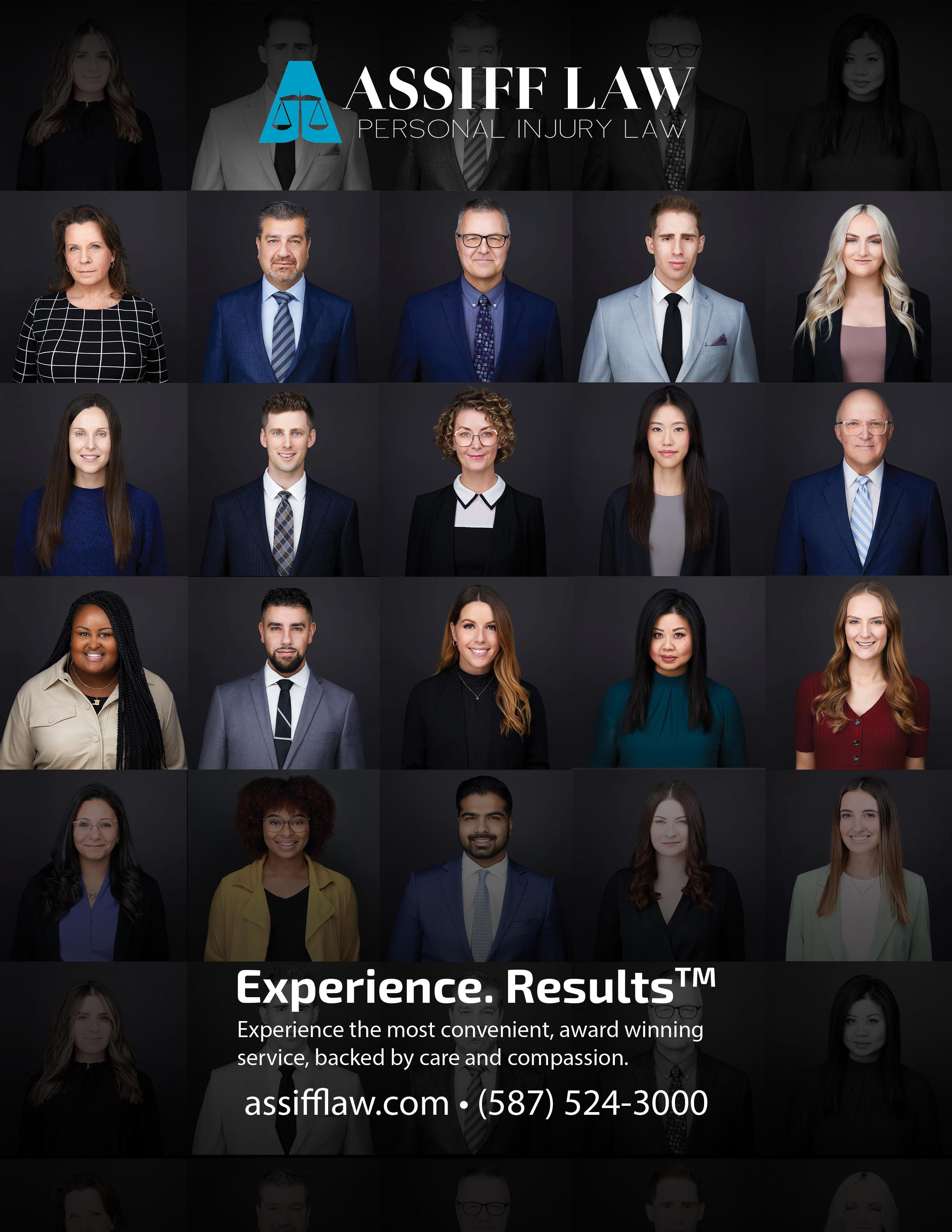Barrister the






• Interest rate DECREASES at the two-year mark
• Legal fees & disbursements always take priority
• Approval within 24 hours
• No hidden fees or recurring charges
• Flat $250 administration fee
• No complicated application forms
• Sustainable and responsible lending decisions


We’ve got your back, so you can












Advocating for a strong civil justice system that protects the rights of all Albertans.
2023-24 BOARD MEMBERS
Chair: Mike McVey
Past Chair: Owen Lewis
Vice Chair: Jillian Gamez
Secretary: Laura Comfort
Treasurer: Travis Bissett
Members-at-Large:
Joseph A. Nagy
Clifford Headon
Dana Neilson
Geographical District Representatives:
North West: Leah Paslawski
North East: Waverly Mussle
Edmonton: Karamveer Lahl
Calgary: Peter Cline
Central: Evan Morden
South East: VACANT
South West: Thomas Kannanayakal
ACTLA STAFF
Executive Director
Joy Jeong | executivedirector@actla.com
Communications and Events Services
Administrator & Editor-In-Chief, The Barrister
Nash Calvert | communications@actla.com
Finance & Member Services Administrator
Lochlin Zhao | membership@actla.com
PAST CHAIRS
Owen Lewis - 2023-24
Angela Saccomani, KC - 2022-23
Maia Tomljanovic 2021-22
Jackie Halpern, KC, 2020 - 21
Shelagh McGregor, 2019-20
Mark Feehan, 2018-19
Michael Hoosein, 2017-18
Maureen McCartney-Cameron, 2016-17
Nore Aldein (Norm) Assiff, 2015-16
Craig G. Gillespie, 2014-15
Donna C. Purcell KC, 2013-14
George Somkuti, 2012-13
Constantine Pefanis, 2011-12
James M. Kalyta, 2010-11
James D. Cuming, 2009-10
Richard J. Mallett, 2008-09
Arthur A.E. Wilson KC, 2007-08
Walter W. Kubitz KC, 2006-07
William H. Hendsbee, KC, 2005-06
Kathleen A. Ryan KC, 2004-05
Ronald J. Everard KC, 2002-04
Stephanie J. Thomas, 2000-02
James A.T. Swanson, 1998-2000
Gary J. Bigg, 1996-98
Stephen English KC, 1994-96
Anne Ferguson Switzer, KC, 1992-94
Terry M. McGregor, 1990-92
J. Royal Nickerson KC, 1988-90
Derek Spitz KC, 1986-88

The Summer Edition of The Barrister is coming!
We are searching for tips, tricks, and stories of you using technology to improve your work efficiency, or that of your firm!
Whether you are an experienced trial lawyer, a law student, or an expert witness, contact communications@actla.com to contribute an article.
Articles should be between 500-2500 words. Longer research articles are accepted as well.


Iampleased to assume the role of Chair of the Alberta Civil Trial Lawyers Association (ACTLA). It is an honor and a privilege to be leading this organization which has an important role in protecting the rights of Albertans and ensuring that the civil justice system meets the needs of those Albertans accessing that system. I am committed to working with the ACTLA Board, ACTLA Members and ACTLA’s Executive Director and staff to continue the fantastic work that ACLTA has done in the past and will continue to do in the future.
As we move forward, ACTLA will continue to advocate against no-fault or hybrid no-fault insurance which would have a detrimental effect on the rights of injured Albertans. ACTLA’s advocacy in this respect is particularly important given that the Alberta Government is currently considering making significant changes to automobile insurance in Alberta and moving away from a tort system and towards a no-fault system.
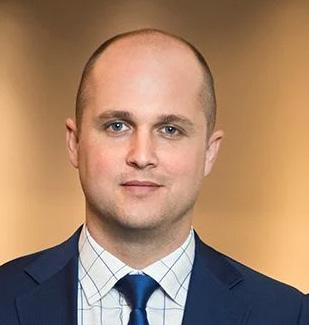
 ACTLA
ACTLA
We will continue to ensure that we advocate in favor of injured Albertans and to work with the Alberta Government and other stakeholders including the medical community, to ensure that the many flaws of no-fault insurance are highlighted. In addition, we will work hard to ensure that Albertans are aware of the possible changes and the negative impacts these changes will have on their civil rights. We will encourace Albertans concerned with the removal of their civil rights to voice their opinions to their MLAs and other government officials as well. ACTLA advocacy efforts will be essential to ensure that nofault or hybrid no-fault insurance does not become a reality in Alberta.
Throughout this year, ACTLA will continue with efforts to increase membership. Not only does a large membership base ensure the continued success of the organization, a large membership base has a large voice which is essential for advocacy efforts. I believe that ACTLA has an opportunity to build membership through working with non-ACTLA members of the civil bar in advocacy efforts for improvements in the civil justice system as a whole. Collaboration is an effective tool to increase membership. In addition, this may build membership by allowing ACTLA an opportunity to work and build relationships with lawyers who practice in areas which were not traditionally an area of focus for past ACTLA members.
As always, ACTLA will continue with its efforts to assist members and non-members with continuing legal education through in-person seminars and online webinars. ACTLA recognizes the importance of ensuring that lawyers have access to current, high-quality content to assist lawyers with providing exceptional services to their clients. In my view, this is important for ACTLAs continuing success as it raises ACTLA’s profile in the legal community and can also help accomplish the goal of increasing membership.
Finally, I want to take the opportunity to thank all of our outgoing volunteers for their dedication to ACTLA over the years. I would also like to thank our incoming volunteers for their willingness to put their time and talents to work in favor of ACTLA’s goals. I look forward to working with you all in ensuring ACTLA’s continuing success.
Yours truly,
Mike McVey
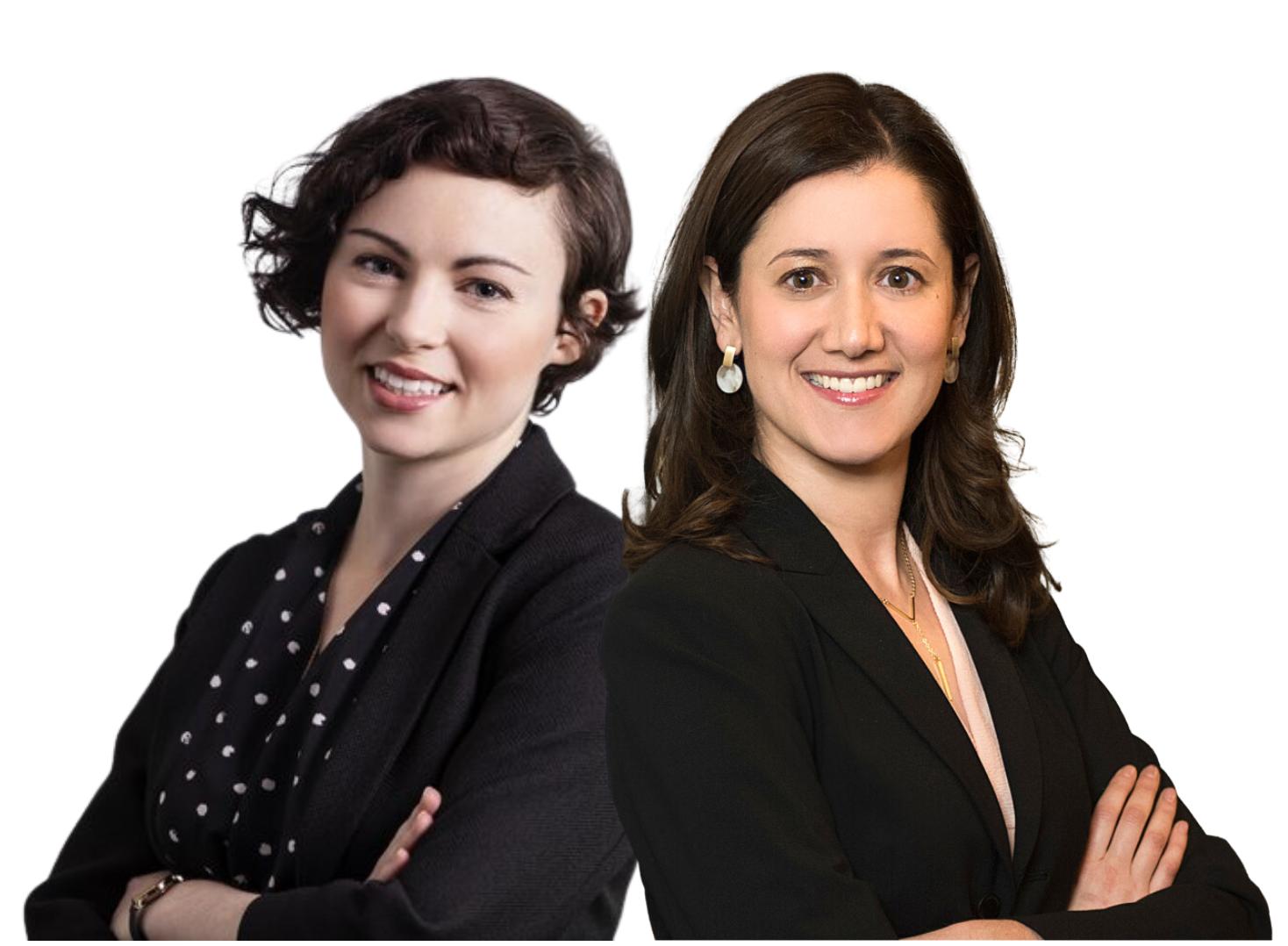
Are you a new parent, or soon to be new parent, in the legal profession in Edmonton?
Join Returnity Yeg, a "Baby & Me" group in Edmonton!
Jillian Gamez and Sasha Lallouz, lawyers in private practice in Edmonton, met at a local Baby & Me group at Nest Integrative Wellness while on maternity leave in 2023. In addition to all things new parent related, they found themselves chatting about returning to lawyering in private practice as parents, and juggling their new bundles of joy into their daily routine when back at the office. After learning about Calgary's Returnity YYC Baby & Me group, a group for lawyers in Calgary with over 40 participants, Jill and Sasha decided to pilot Edmonton's Returnity chapter.
Babies are welcome!
If you are a lawyer in Edmonton who will be on parental leave during that time, and are interested in joining Returnity Yeg, please email returnityyeg@gmail.com to indicate your interest and receive further information. As this is a pilot program, Returnity Yeg is considering the possibility of accommodating zoom attendance for flexibility and to include lawyers outside of Edmonton in northern Alberta.
For sponsorship inquiries to assist with costs, such as meeting space rental and speakers, please email returnityyeg@gmail.com for more information. We thank you in advance for your interest.


 Joy Jeong, Executive Director ACTLA
Joy Jeong, Executive Director ACTLA
The passing of March is a transitional time for our association as it marks the changing of our board. With that being said, I would like to start this letter with a tremendous thank you to the 2023-2024 board for all their hard work and service over the last year. I would like to extend an extra thank you to Owen Lewis for his time as the ACTLA Chair.
Looking forward, with Mike McVey taking over as the ACTLA Chair, I am hopeful and excited for the coming year and all we can accomplish.
Already 1 quarter into the year, our main event of the first half of the year is fast approaching. We have the Plaintiff’s Only Seminar coming up this May, and I’m looking forward to the great speakers we have lined up. I hope to see many of our members attend our first in person event of the year.
Additionally, we are already well into our lobbying efforts for the FAIR Campaign for this year. You may have already seen our commercials aired on Hockey Night in Canada, as well as heard our commercials on radio stations such as 630 CHED. We are maintaining our close relations with government, and continuing to advocate against no-fault insurance in Alberta. Thank you to all those who have donated so far to our efforts this year. Without the support of our donors, we would not be able to continue to advocate for our members and for Albertans. Your contributions are crucial to our work, and every single dollar counts. So thank you to all those who donate, and to those who continue to share our message and spread ACTLA’s reach.
Coming up soon, we also have our 2024 membership renewals, and members can expect notices for renewal to begin going out in May. We would love to continue growing our ACTLA Membership, so we encourage our members to invite their colleagues to join our association.
As always I invite you to reach out with questions, comments and suggestions (or even to just say hello). I can be reached directly at executivedirector@ actla.com.
Sincerely,
Joy Jeong Executive Director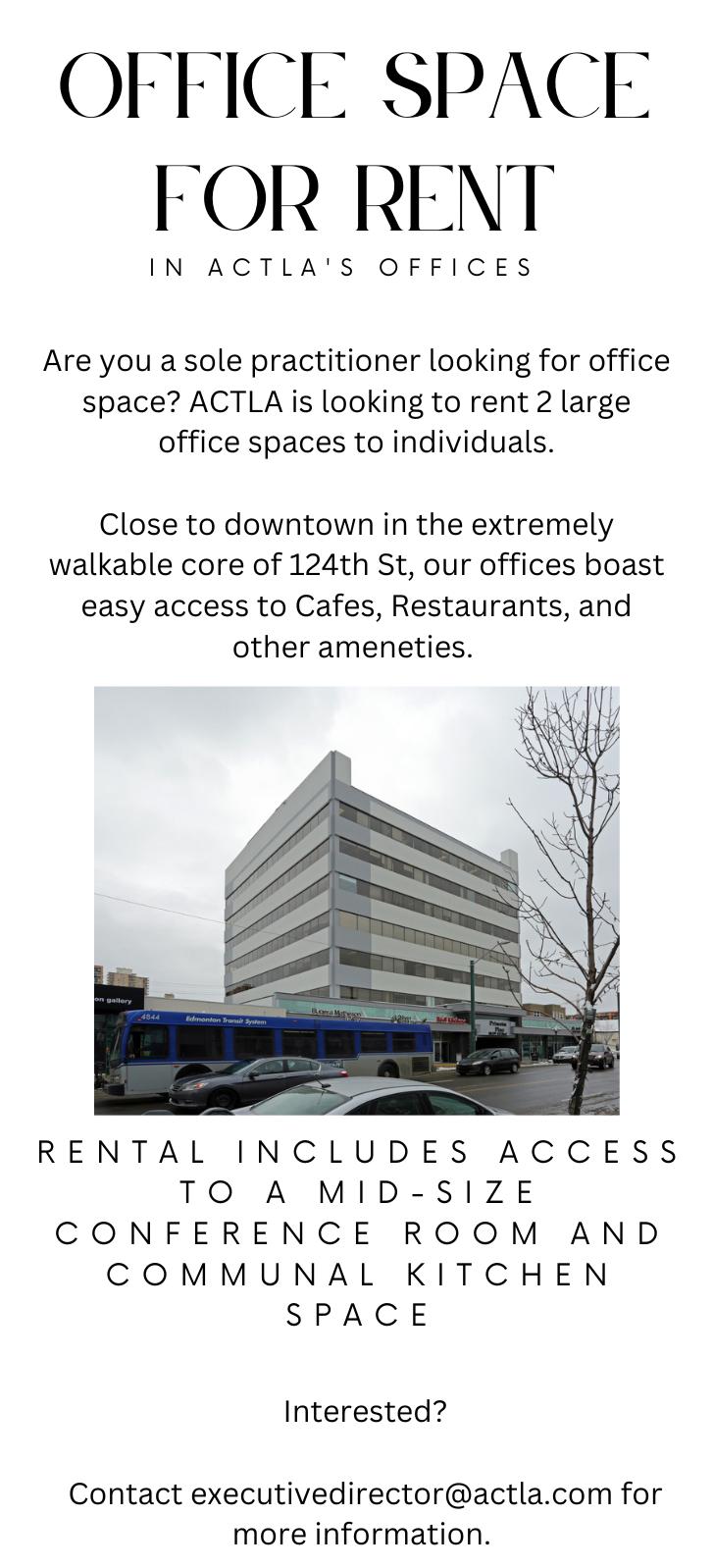

Aswe stride into the second quarter of 2024, I am pleased to bring you an update on behalf of the Alberta Civil Trial Lawyers Association (ACTLA) regarding our membership and financial standing.
The heart of any association lies in its members, and I am delighted to share the exciting news that our membership has experienced a significant surge over the past year. From May 2023, we have seen a remarkable growth trajectory, transitioning from just scraping by with 350 members to nearly reaching the 500-member milestone. This accomplishment is a testament to the concerted efforts of our dedicated team, including our communications coordinator Nash, executive director Joy, and myself. Through strategic outreach initiatives and enhanced communication channels, we have successfully attracted new members and strengthened our community of legal professionals dedicated to civil trial practice in Alberta. We hope to bring membership figures above 550 before the next annual renewal date. Membership for existing members will be expiring on May 31st, 2023, so I would like to gently remind everyone to consider renewing soon.


In addition to our flourishing membership base, I am thrilled to report on the robust financial health of ACTLA. Thanks to the generosity and support of our members, we have received over $250,000 in donations, which have played a pivotal role in sustaining and advancing our mission. We are deeply grateful for your contributions, which have enabled us to continue providing valuable resources, advocacy, and networking opportunities for our members.
Looking ahead, we aspire to build upon this success and aim to surpass the milestone set by our previous fundraising efforts. Achieving this goal would not only signify a greater financial contribution towards our initiatives but also reflect the unwavering commitment and solidarity of our members towards the advancement of civil trial practice and access to justice in Alberta.
Rest assured, ACTLA is in a position of strength when it comes to our finances, and we are committed to upholding sound fiscal management practices to ensure the longevity and sustainability of our association. With prudent planning and execution, we are confident in our ability to maintain our current financial standing and continue serving the needs of our members effectively
I extend my heartfelt appreciation to each and every one of our members for your unwavering support and dedication to the Alberta Civil Trial Lawyers Association. Together, we have achieved remarkable milestones, and I am excited about the journey ahead as we continue to grow and thrive as a community.
Should you have any questions or require further information, please do not hesitate to reach out to me or our team. Thank you for your continued commitment to ACTLA.
Warm regards,
Lochlin Zhao Finance and Membership Services Alberta Civil Trial Lawyers Association
As my term as Chair draws to a close, I would like to convey how deeply honoured I am to have been able to serve on this Board alongside such incredible people. I am privileged to have served a membership dedicated to preserving the rights of innocent injured victims and tirelessly advocating for access to justice.
At the start of the year our Board set out with three main objectives: to increase membership, to offer meaningful educational opportunities, and, finally, to continue to advocate against changes to Alberta's automobile insurance regulations which would see a no-fault or hybrid no-fault system implemented in Alberta.
Throughout the year, our association diligently tracked progress, challenges, and achievements that ensured transparency and guided our actions. Despite facing numerous obstacles, our membership numbers increased by 15% where we currently have 456 paid members. We anticipate that this number will continue to increase on an annual basis as we have developed relationships at the University of Alberta, created inroads at the University of Calgary, and have expanded membership to numerous firms who were previously not members of our organization.
The Seminars Committee did an incredible job presenting numerous online seminars throughout the year and in-person conferences. The final in person Masterclass conference had amazing speakers and was well attended, considering post-Covid conditions, and will certainly be a springboard for the in-person seminars which will take place in 2024. The feedback received was universally positive.
2023 saw the election of a new UCP Government in Alberta and ACTLA has been faced with the challenge of countering the advocacy efforts of the IBC, who are seeking to further limit the rights of injured Albertans, which seems to arise every time the new provincial government is elected. ACTLA remained steadfast in advocating for the rights of injured Albertans. However, our efforts are particularly tested by the looming threat of the proposed no-fault or hybrid no-fault insurance systems. These proposals, actively promoted by industry stakeholders and supported by lobbying efforts, pose significant risks to the rights of innocent victims and the integrity of our justice system. With a report expected soon, which will likely tout the advantages of systems in jurisdictions like New Jersey and New South Wales, our advocacy efforts on behalf of injured Albertans will continue to be tested.
However, ACTLA can take some credit for the profit cap on insurance companies which was implemented by the Alberta Government as the first phase of their policy initiatives. This comes directly from the advocacy efforts of ACTLA members and is a testament to our standing as a stakeholder in these discussions. We hope to be included as a relevant stakeholder in any further discussions of legislative changes that the Alberta government may consider. It appears that ACTLA stands alone as one of the only consumer advocates in relation to private passenger automobile insurance in Alberta.
On a personal note, I would like to extend heartfelt gratitude to Angela Saccomani, Past Chair, for her invaluable assistance, guidance, and unwavering dedication to the mission of the association. Angela's leadership and the leadership of the Chairs before her have been instrumental in steering the organization through challenges and fostering a culture of excellence. I further extend my appreciation to the Board members for their unwavering commitment, diligence, and perseverance throughout the year. Their collective expertise, passion, and tireless efforts have been instrumental in advancing the goals of the association. Being a member of the Board entails more than simply attending board meetings, as each member is an advocate for the ideals of ACTLA and we have tasked the Board members with additional work during these challenging times.
Furthermore, I express gratitude to all Committee members for their invaluable contributions. Special mention goes out to the Barrister Committee for publishing engaging and educational publications and dealing with the challenges of going digital. Further mention goes out again to the Seminars Committee for coordinating the educational offerings this year and securing world-class speakers for the in-person events. Finally, thanks goes out to the membership of the Task Force Committee, many of whom spent countless hours educating medical professionals, legal professionals, and government officials on the negative implications of the IBC's proposals and of no-fault systems generally. No doubt we will require the continued efforts of all these Committees to accomplish our association's goals in the coming years.
A special acknowledgment is also due to our Executive Director, Joy Jeong, whose organizational skills, leadership, dedication, and tireless efforts have been instrumental in guiding the association forward. I extend my gratitude to Joy, as well as her staff, Nash Calvert and Lochlin Zhao, for their hard work and contribu-


tions throughout the year. As I step down from my role, I extend warm congratulations and best wishes to Mike McVey as the new Chair of the Alberta Civil Trial Lawyers Association. I have full confidence in Mike's leadership abilities, dedication, and commitment to upholding the values and mission of the association. I am confident that under his guidance, the association will continue to thrive and remain at the forefront of educating our members, advocating for injured Albertans, fighting against destructive tort reform, and ensuring access to justice for all Albertans.
In closing, I am immensely proud of the accomplishments and progress achieved by the Alberta Civil Trial Lawyers Association in its relatively short 36-year history, and I am humbled to have been a small part of it. As we look ahead to the future, I am confident that our collective efforts will continue to make a meaningful impact in the pursuit of justice and fairness for all Albertans.


Ithink it is safe to say that Spring has officially sprung - despite the erratic mood swings of our province's weather this year. In the spirit of spring and renewals, I would like to officially welcome our new Board to their roles and thank the dedicated members of the Editorial Board for their assistance in putting together the Barrister.
While the previous edition was the largest ACTLA has ever prepared, this edition is decidedly smaller. We elected for a smaller edition to give ourselves time to recoup from the previous edition while also preparing content in advance for later editions. Rest assured, this edition may be smaller but it is no less dense.
In honour of the new year, ACTLA once again hosted our Case Law Review webinar, one of ACTLA's highest-attended educational programs ever. Laura Comfort has provided The Barrister with some additional case highlights that were not covered in the webinar - and the webinar materials and recordings are now available for purchase at the ACTLA we store for further review. If that's not enough for you, this edition's Rules Summaries, graciously provided by JSS Barristers, should be a veritable feast for your review.
 Nash Calvert Editor-in-Chief, The Barrister Communications & Event Services Admin, ACTLA
Nash Calvert Editor-in-Chief, The Barrister Communications & Event Services Admin, ACTLA

In the previous edition, we set out to frame the discussion around No-Fault Insurance and proactively define many of the models (including British Columbia, Saskatchewan, and Australia's New South Wales) that we know are referenced during these discussions. In this edition, I am happy to report that we were able to field an article from the Ontario Trial Lawyers Association discussing how No-Fault has affected their province. As a result, I am confident that these two editions taken together will provide a robust framework for our continuing discussions with the Alberta Government as we continue to advocate against No-Fault systems.
The final two articles in this edition discuss the brain. Priscilla Cicek's Case Law Corner submission for this edition focuses on aneurysms and stroke, particularly their affects on individuals' mental state from both a medical and legal perspective. From Bottom Line Research, the article "Assessing Remoteness in Family Members Claims of Psychological Injury" will be the perfect resource for determining if a psychological damages claim by an indirect plaintiff is likely to be successful or not.
While the content of this Barrister edition may be reduced from the previous, ACTLA is in no way cutting back on the opportunities for you to continue your education. This year's Plaintiff's Only Seminar will have been officially announced by the time this makes its way to you, and we look forward to hosting you and our roster of speakers at the Sandman Signature Downtown Edmonton on May 28th and The Dorian/Mariott Courtyard Downtown Calgary on May 30th.
As always, we are constantly seeking new contributors and advertisers for The Barrister - if you have an article, research paper, or any other contribution you feel would be of value to our publication, please contact communications@actla.com to send it in!
Sincerely,
Nash Calvert Editor-In-Chief & Communications/Event Services

In the midst of ongoing discussions around auto insurance reform in Alberta, a recent poll has shone a light on the attitudes of Albertans. Conducted by Janet Brown Opinion Research and commissioned by the advocacy coalition Fair Alberta Insurance Regulations (FAIR Alberta), the findings reveal a significant preference among Albertans for the existing "at-fault" insurance model over the proposed "no-fault" system. This article delves into the intricacies of the poll and digs into what is motivating opinions and their implications for future insurance policies.
Publicly released in early April, the survey outcomes are eye-opening. A commanding 63% of Albertans have voiced their support for the at-fault insurance system. This figure starkly contrasts with the mere 25% favoring a shift towards a no-fault system, alongside 4% showing interest in a mixed system, and 8% remaining undecided. This pattern of preference not only underscores a significant resistance to change but also mirrors sentiments captured in a similar 2021 survey, highlighting a consistent provincial stance over time.
Janet Brown, the pollster who conducted the research, pointed out the significance of these results, stating, "Our data shows a majority of the population is not only familiar with the current system but also prefers it over the alternative no-fault model.” This preference signals a deep-seated comfort and satisfaction with the status quo, wherein the financial responsibility for an accident falls upon the at-fault party, aligning with the principles of accountability and justice.
The survey also explored perceptions of fairness related to the no-fault insurance model, particularly its approach to treating responsible and non-responsible parties equally and its prohibition on suing at-fault drivers. The feedback was overwhelmingly against these aspects, with 61% opposing the equal treatment of victims and at-fault drivers, and 71% disapproving of the restriction on legal actions against at-fault individuals.
Jackie Halpern KC, a spokesperson for FAIR Alberta, emphasized the importance of accountability, stating, "Albertans are clearly saying victims of accidents caused by bad drivers should have the right to hold the responsible parties accountable – that’s just an Alberta value – personal responsibility.”
Despite the resistance to a no-fault system, there is a desire among Albertans for insurance reform, but they say it should be specifically aimed at reducing premiums within the at-fault framework. 68% of respondents advocated for government to explore reforms within the at-fault framework and only 16% said the government should considering no-fault systems as a solution. Halpern criticized the no-fault approach for its potential to diminish consumer power, stating, “A no-fault system takes power away from consumers and puts decisions solely in the hands of insurance companies.” FAIR Alberta continues to advocate for reforms strategy that promote affordability, accountability, and expanded consumer choices without compromising Albertan rights.

Interestingly, the survey also indicated a growing awareness among Albertans about no-fault insurance, with a 10-point increase in familiarity since 2021. This heightened awareness is not solely the result of public discourse; it's also significantly driven by FAIR Alberta's proactive engagement through various media channels.
The advocacy group has amplified its message across TV, radio, and online advertising platforms, casting a wider net to educate and inform Albertans about the implications of auto insurance reforms. This multi-pronged approach to communication ensures that the debate around no-fault versus at-fault insurance is not only more visible but also accessible to a broader audience. The strategy underscores FAIR Alberta's commitment to fostering informed discussions on the subject, promising more engaged and thoughtful dialogue among the public and policymakers alike. This concerted effort to raise awareness plays a crucial role in shaping the future of auto insurance in Alberta, aligning with
the preferences of Albertans for a system that embodies fairness, accountability, and affordability.
The survey, which polled 900 Albertans between January 8 to 15, 2024, has a margin of error of +/- 3.3 percentage points, 19 times out of 20. Its findings not only reflect a strong provincial consensus but also illuminate the path forward for policymakers, underscoring the need for reforms that align with the public's preference for fairness, accountability, and affordability in the auto insurance sector.

Stop hindering the ability to take on new files, manage operating expenses, and invest in growth.
The answer: specialized law firm funding solutions.
Unlike traditional lenders, we fully understand the litigation practice business model. Deferred legal fees, unpredictable file durations and increasingly onerous disbursement requirements result in unique funding challenges that banks cannot address. We can.
Expert Access combines two essential services for lawyers: sourcing qualified experts using our proprietary Expert Search tool and deferring payment until settlement with no interest for two years.
A flexible tool law firms can use to finance any disbursement, on any file, at their discretion. Repayment is deferred until settlement of the underlying file, perfectly in line with a firm’s cash flow.
BridgePoint not only understand the contingency fee business model better than any bank, their disbursement funding solutions are tailor designed for it, with payments perfectly mirroring my settlement cashflow.














It was the best of times, it was the worst of times…

Charles Dickens’ well-quoted line is an apt descriptor for 2023 from a civil caselaw perspective. With respect to this year’s plaintiffs, judges seemed to feel “it was the epoch of belief, [or] it was the epoch of incredulity.” While the decisions themselves were varied, in their substance, their outcomes, and even their writing styles, one simple fact remains consistent: evidence and its impact on credibility makes or breaks a claim. While this point may seem obvious to seasoned counsel, recent cases highlight the importance of keeping evidence in the fronts of our minds as we attempt to assess risk and resolve claims.
The two cases of Camacho v Lacroix, 2023 ABKB 610 and Armbruster v Nutting, 2024 ABKB 36 provide a useful look at the impact of evidence on damages in personal injury damages in Alberta. The plaintiffs in each of these cases were both injured in rear-end motor vehicle collisions. Looking at these two cases together demonstrates how different plaintiffs with similar injuries and similar general damages awards can still walk away with two very different overall settlement amounts.
The Plaintiff in Camacho suffered from chronic neck and right shoulder pain, right arm weakness and tingling, headaches, sleep disruption, cognitive issues, and a TMJ injury. Justice Devlin found her to be a largely credible and sympathetic witness –highlighting her background of receiving medical training in Columbia, her military service, and her immigration to Canada. He considered Ms. Camacho to be a hard-working individual who had overcome significant adversity. While her pre-accident mental health issues resulted in Ms. Camacho not being entirely forthcoming with her treatment providers after the accident and there being some gaps in her treatment records, Justice Devlin stated that it impacted liability more than credibility.
The Plaintiff in Armbruster suffered similar injuries – a mild traumatic brain injury with associated headaches, TMJ injury, cervical myofascial pain, adjustment disorder, and PTSD. Justice Wilson immediately identified issues with Mr. Armbruster’s credibility, noting that his testimony and medical records often did not align. There were also several gaps in his treatment records. Because of Justice Wilson’s profound concerns with Mr.
Armbruster’s credibility and reliability as a witness, he also took issue with the expert reports that were based on Mr. Armbruster’s self-reported injuries and symptoms.
Despite how differently these two plaintiffs were perceived by their respective trial judges, both were awarded fairly similar amounts for general damages: $95,000 for Ms. Camacho and $70,000 for Mr. Armbruster. Based on this metric alone, it may appear that these plaintiffs’ presentations did not significantly impact their awards. However, awards under other heads of damages, reductions for failure to mitigate, and the final outcomes of each of these cases demonstrates how that is not always the case.
In Camacho, despite some gaps in her treatment record, it was sufficiently clear that Ms. Camacho was consistent in receiving treatment and was experiencing chronic injuries. She was going to require further treatment for these injuries. As such, she was awarded a significant future care award of $99,250.00.
However, her award for loss of earning capacity was a major issue. Both methods used by her counsel to calculate this loss were considered too speculative. The first loss of earning capacity calculation was based on her qualifying as a doctor in Canada. While she had medical training from her home country of Columbia, Justice Devlin found that the difficulty of the qualification process, particularly for someone with Ms. Camacho’s language issues and mental health challenges, meant that the evidence did not prove on a balance of probabilities that she would have achieved the qualification if not for the accident. Justice Devlin further rejected the level of disability used by the Plaintiff’s
economic expert, noting that the medical record did not support the severity of the claim. Despite these issues, he held that the evidence supported, on a balance of probabilities, a 15% reduction in her future earnings due to her injuries. Her loss of earning capacity award was calculated based on this amount.
The total damages award for Ms. Camacho broke down as follows:
• General damages: $95,000.00
• Past Loss of Income: $0
• Future loss of income: $261,000.00
• Cost of future care: $99,250.00
• Special damages: $16,048.85
• Total: $471,298.85
Conversely, in Armbruster, the Plaintiff’s credibility remained a significant issue, which pervaded the judge’s view under each head of damages and saturated the judgment. As such, there was no demonstrable past or future loss of income award. Of note, the Plaintiff had taken a leave from work and then retroactively tried to get doctors’ notes to retroactively make it into a medical leave. Justice Wilson did not accept this as a medical leave, as he did not see sufficient support in the evidentiary record.
Further, Mr. Armbruster’s evidence suggested a failure to mitigate his injuries. There were several medical records indicating recommendations for treatment that Mr. Armbruster did not follow. As such, his entire award was reduced.
The total damages awarded to Mr. Armbruster were:
• General damages: $70,000.00
• Special damages: $51,898.00
• Future costs of care: $30,000.00

• Loss of income/earning capacity: $0
• Subrogated claim: $7,765.00
• Subtotal: $159,663.00
• Failure to mitigate: 40% (-$63,865.00)
• Total: $95,798 (plus interest, costs, and disbursements).
It is not revolutionary to conclude that a plaintiff who presents well, with consistent testimony and medical documentation, will fare better than an inconsistent, unreliable plaintiff with spotty records. However, these two cases show just how significant that difference can be. The plaintiff in Camacho walked away with over $375,000 more than the plaintiff in Armbruster, despite the similarities in their accidents and injuries. The value of strong and cogent evidence, together with a sympathetic and prepared plaintiff, cannot be overstated.
The decision of Couch v Olatiregun, 2023 ABKB 104 represents one of the first times we’ve seen a court award damages below the amount in the Minor Injury Regulation (also known as the “cap” for minor injuries). This case serves as a warning for counsel dealing with potentially capped claims to ensure that we are presenting our client’s best possible case to avoid getting caught under it.
The plaintiff was in a rear-end motor vehicle collision. His injuries included pain and stiffness in his neck, upper back, shoulder, middle back, and ribs. He also experienced some headaches. His symptoms lasted approximately 10 weeks, with his headaches persisting intermittently for 8-9 months more. The Plaintiff had treated for approximately nine months with massage, chiroprac-
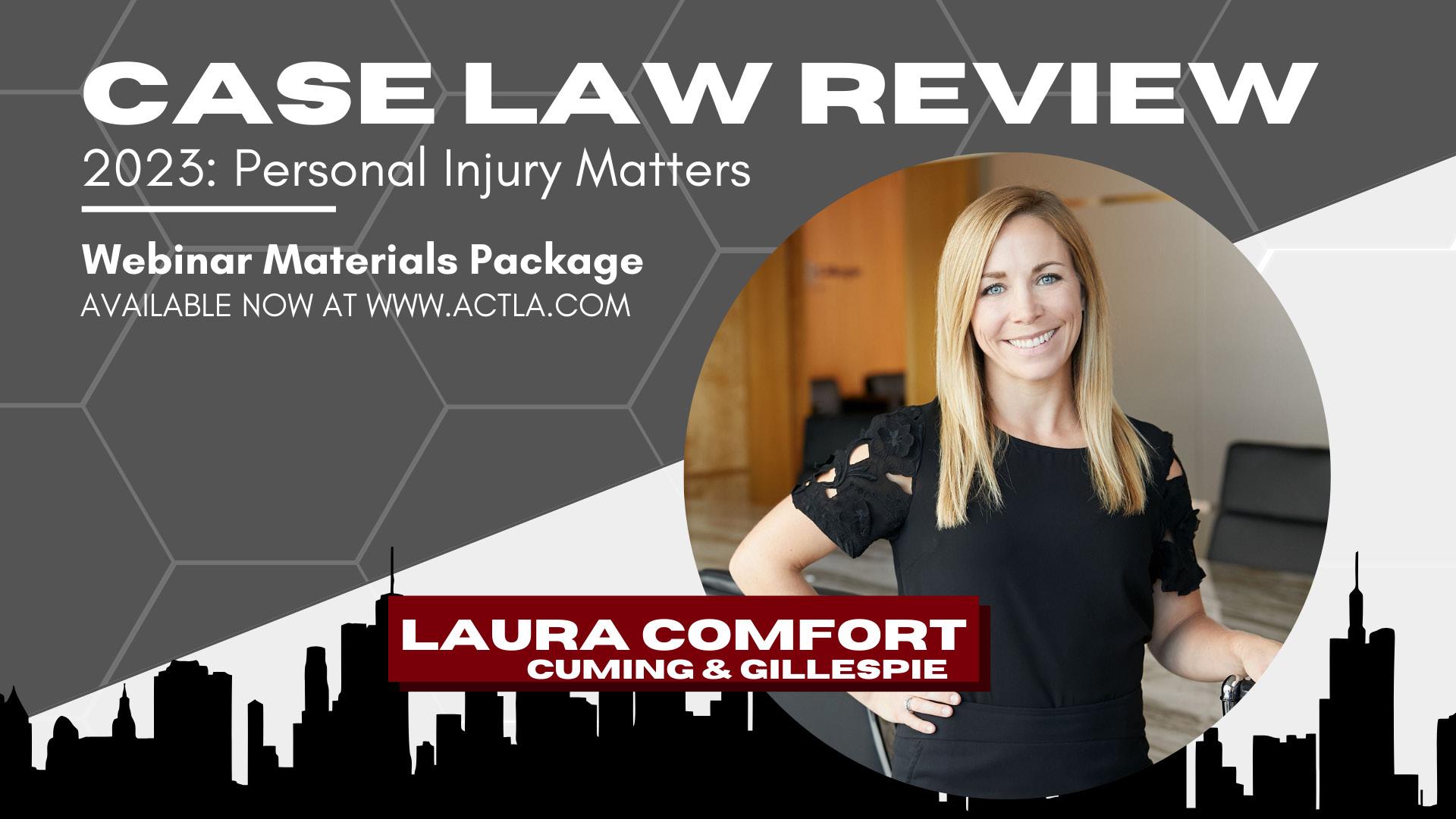

tic, and acupuncture treatments. He reported returning to his baseline – which included some pre-existing neck and back pain.
Despite hearing no contradictory evidence (because the self-represented defendant did not appear at tri al), Justice Sullivan held that the plaintiff’s injuries fell under the declined to award the full cap – even at the unadjusted value – instead awarding $3,000.00 (plus limited special damages). While his reasons outline why he decided the claim was capped, there is no discussion explaining his reasons for awarding below the full cap amount.
Of note, there are some gaps in this decision. For exam ple, Mr. Couch’s doctor diagnosed him with a WAD II injury (see para 15). However, Justice Sullivan’s finding was that the injury was categorized as WAD I. It is un clear from a reading of the decision what evidence was relied upon as the basis for this finding.
This case serves as a clear warning that judges can and will award below the cap and that they may do so with out opposing evidence or detailed reasons. It reminds us that we must always put our best evidentiary foot forward at all stages of a claim, no matter who may or may not be defending the claim, to avoid a highly unfa vourable decision.
These recent Alberta cases all serve to remind us of the evidentiary burdens that we have as counsel, particularly those of us representing plaintiffs. Proving the plaintiff’s case on a balance of probabilities requires the utmost diligence in preparing the evidentiary record in such a way that it supports our position on damages while also addressing any gaps or concerning aspects the case.
Of note, in many of these cases, speculation was the downfall of the plaintiff’s position. For example, in Camacho, the speculative nature of the loss of earning capacity argument meant that the plaintiff’s award was significantly less than she had claimed. In Armbruster, the Plaintiff’s own speculation about his condition where there was a lack of medical evidence served as a death blow to his credibility.
While it may seem simple, a strong evidentiary foun dation remains the cornerstone of civil decisions and should always be front of mind for us as counsel. We should continue to have “great expectations” about the power of evidence in meeting our burdens under the law.

For more information on case law updates in 2023, purchase the 2023 Case Law Review webinar and materials at www.actla.com
To

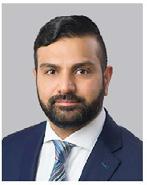
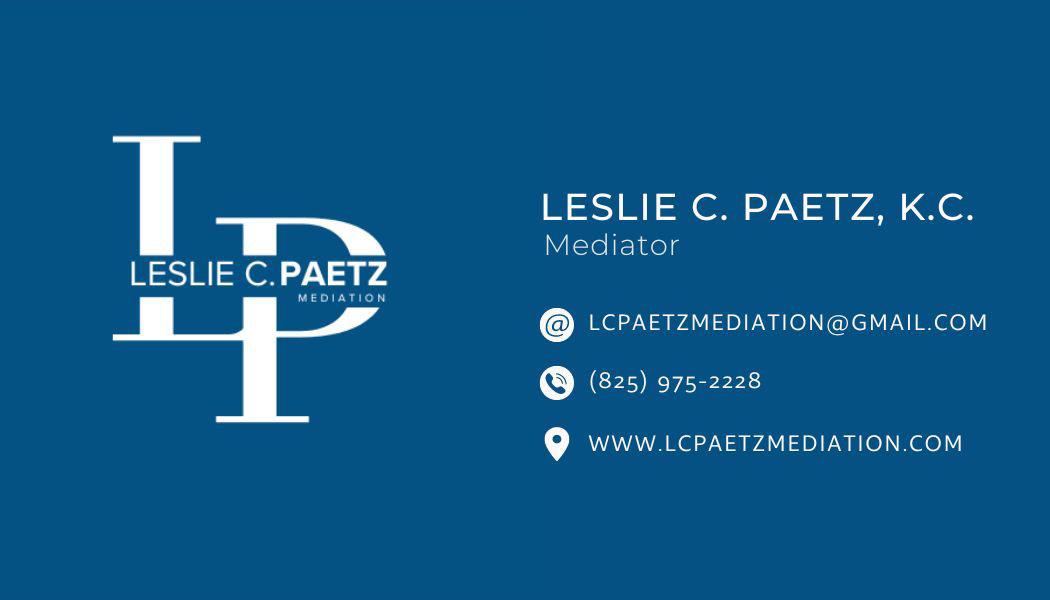
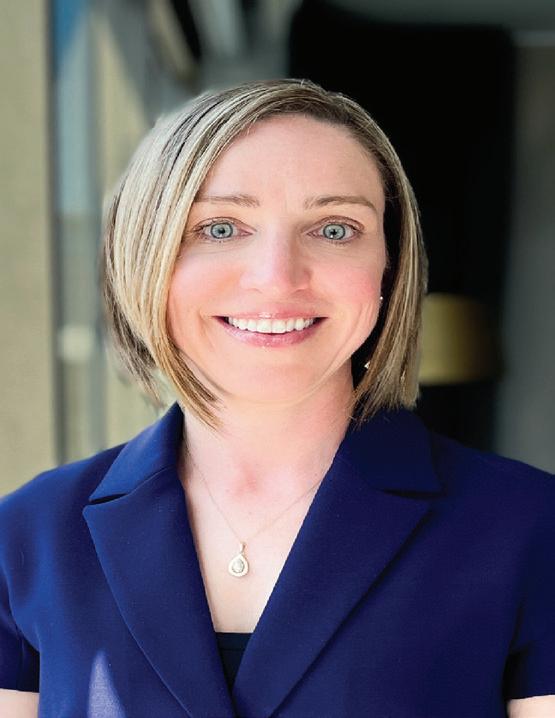



Ontario’s no-fault regime is a broken system. It’s paperwork heavy, invites serious delay, too often offers empty benefits, and horribly short-changes people who have been hurt in auto collisions. It’s an unjust regime for the injured, and a beautiful one for insurers.
Ontario’s no fault auto system was created in 1990. Legislators called their creation “Statutory Accident Benefits” (“Accident Benefits”). But make no mistake, it came at a great cost, especially to those hurt in auto collisions because of another driver’s negligence. In exchange for these no-fault auto benefits, motor vehicle insurers needed something big in return. And they got it. The “protected defendant”.
What’s a “protected defendant”? It’s anyone who is responsible for an injury or death arising from the use or operation of an automobile who was either present at the scene or inside an automobile involved in the incident. But that only tells you who the protected defendant is and not how they’re protected.
A protected defendant (read the insurance company covering the protected defendant) does not have to pay for any income losses suffered in the first week after an auto crash. NOTHING! After that, insurers only have to pay for 70% of the income losses up to the date of trial.
Then there is also something called a “deductible” and the “threshold”. As of today, there is a $46,000 deductible on pain and suffering damages.1 It’s not $4,600, but $46,000! That means if a Judge or jury assesses your pain and suffering at $50,000, then $46,000 of that goes back to the insurer and you, the person actually hurt by someone else’s carelessness, only get to keep a whopping $4,000. Sound fair? What’s worse? The deductible
1 It’s actually $46,053.20.
goes up every year with inflation. And while the deductible completely vanishes for pain and suffering assessed at more than $153,500,2 that upper bar also gets higher and higher every year with inflation.
But that’s only the deductible. Don’t forget about the “threshold”. Plaintiffs are not entitled to any pain and suffering or health care costs unless they have a permanent and serious injury that affects an important function. So even if a jury assesses your pain and suffering thinking YOU will be given those funds as fair value for what was taken from you, the insurance company can then bring a threshold motion to have those funds TAKEN AWAY from you. Why? Judges decide if a plaintiff meets the threshold, not juries.
What’s even worse is that the jury will not even know about the threshold motion or that the money was taken away. And they can’t be told about the deductible either. These special rules must be kept a BIG SECRET.
The number of people who are covered by Accident Benefits is quite broad. It applies to occupants (drivers and passengers) and non-occupants (cyclists and pedestrians) involved in an Ontario “accident”3 with an insured automobile. In many cases, they can be provided to people who were involved in a crash outside of Ontario too.4 In certain scenarios, Accident Benefits are even available to people who were not involved in an accident themselves but who are nevertheless suffering psychologically
2 It’s actually $153,509.39.
3 “Accident” is a defined term. It is any incident in which the use or operation of an automobile directly causes an impairment or directly causes damage to any prescription eyewear, denture, hearing aid, prosthesis or other medical or dental device.
4 You must be a named insured in an Ontario auto policy, a specified driver under such a policy, the spouse of a named insured, or a dependent of a named insured or of his or her spouse. Or you must be an occupant of an insured automobile involved in the accident who resided in Ontario at any point within the last 60 days before the crash.

because a family member or dependent was hurt in one.5
There is a standard set of auto benefits that are provided. A list of them is as follows.
1. Death Benefits
2. Funeral Benefits
3. Income Replacement Benefits (IRBs)
4. Non-Earner Benefits (NEBs)
5. Med / Rehab
6. Attendant Care
However, if you have suffered a catastrophic impairment because of an auto crash then you also have access to certain additional benefits and certain extended benefit limits too. A list of what else you can access is as follows.
1. Housekeeping and home maintenance
2. Caregiver Benefits
3. Extended Med / Rehab and Attendant Care Benefits
When you are catastrophically impaired, your monthly attendant care limits go up from $3,000 to $6,000 per month, and your med / rehab and attendant care overall limits increase from $65,000 total over 5 years to $1,000,000 total over your lifetime.
This is the standard package. There are also add-ons you can get called “optional benefits”.
5 You must be a named insured, specified driver, spouse of a named insured, or dependent of a named insured or of his or her spouse who suffers a psychological or mental injury because of an accident inside or outside Ontario that resulted in a physical injury to their spouse, dependent, spouse’s dependent, child, grandchild, parent, grandparent, or sibling.
Sadly, benefits have been slashed over the last 10 years. The system was gutted before then too. But that’s the topic of another article. There are LOTS OF BIG PROBLEMS with what’s left. I will hit the highlights.
The big problem with IRBs is how they’re calculated.
First, your IRB only pays up to 70% of your income loss. And if you have a lawsuit, the IRB will be deducted from your income loss claim. This means that hefty 30% discount auto insurers get in your lawsuit can’t be recouped through no-fault benefits. Remember, if you start an action, insurers only have to pay 70% of your income losses to trial. I called it a discount but it’s really a gouge.
On top of that, the IRB is capped at $400/week! That’s only $20,800 annually! $20,800 per year is BELOW THE POVERTY LINE. And while the secret deductible increases every year with inflation, the IRB has NEVER been adjusted for inflation!!! It’s the same amount it was 34 years ago.
Approximately 70% of every dollar you earn after your crash is deducted from your IRB – not your loss. I can highlight the unfairness with an example. Let’s say you make $130,000 per year. However, after your horrible car collision you are only able to work at less than 25% of your capacity. Let’s say you’re only making $30,000 per year, which is an annual loss of $100,000. Now you might think that you’ll be entitled to 70% of that $100,000 loss up to $400/week. But you would be wrong! 70% of what you’re taking home is more than $400 per week and so your IRB amounts to ZERO!
But if you can’t work, you may qualify for social assistance or
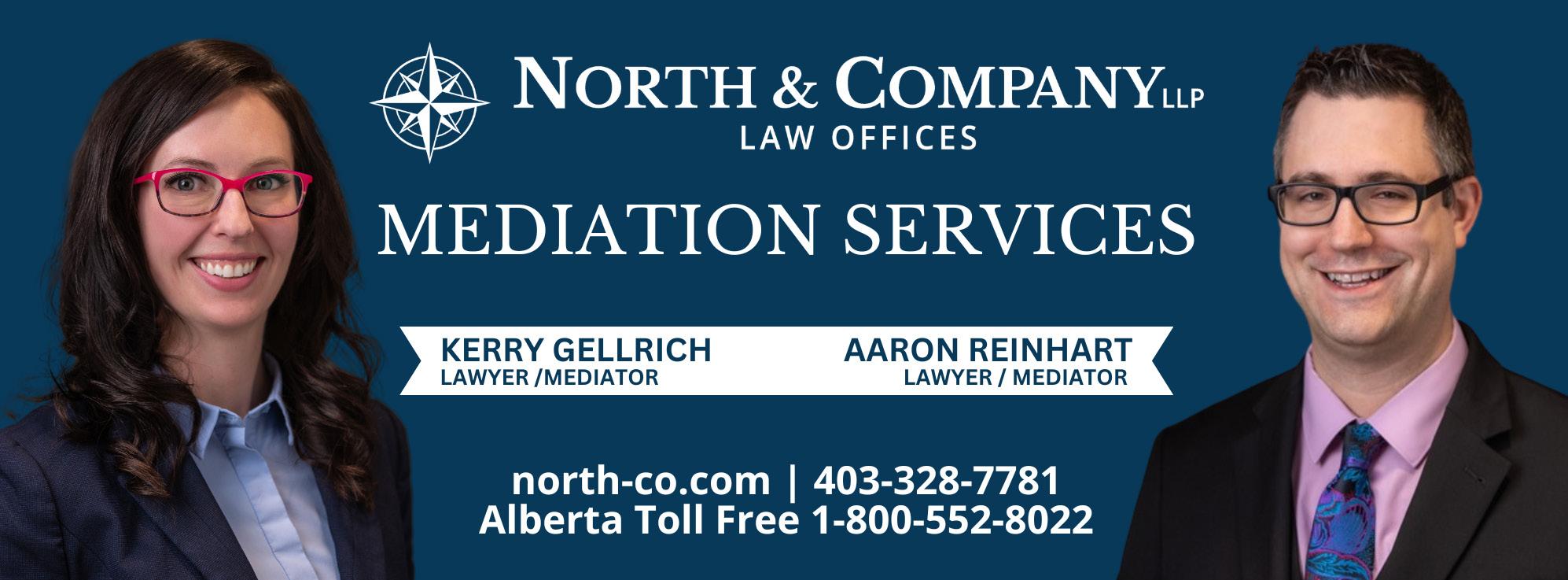

Canada Pension Plan Disability. You may get LTD. You can stack the payments to recoup your losses, right? No! Everything gets deducted or offset one way or the other. You can’t stack! – not even to recoup your losses to make you whole again.
You may think that med / rehab in our no-fault world operates like health benefits through work. You have a certain limit, you go to treatment, submit your costs, and then get compensated. Perhaps, occasionally, your insurer may ask for a medical note to justify your claim. But that’s not how no-fault works.
Instead, your treatment providers must submit a treatment plan to your insurance adjuster for approval. Once that’s done, then another must be submitted. Then another, and another. The adjuster, who is not a physician or health care professional,
And like med / rehab, you must submit your plan to the insurance adjuster for approval. The adjuster will then determine if it is needed.
If you have not suffered a “minor injury” or a catastrophic impairment, then your med/rehab and attendant care benefits have a combined limit of $65,000 that’s available for 5 years.
While that may not sound too bad, you must remember that fewer than 20% of claimants fall into this category. The overwhelming majority are thrown into the Minor Injury Guideline (for an apparently “minor injury”).
"...adjusterswillonlypaysignificantlyreducedratesin accordancewithaguidelinecreatedbackin2014.That meansifyouneedtreatment,youmaynotbeabletofind anyonetotakeyouonasapatient..."
then decides whether the treatment your very OWN health professionals are recommending is needed. If they are unsure, they won’t ask for a report from the treating health professionals, but they will hire one of their preferred health professionals to do an insurer examination (“IE”). These IEs most often limit or rejects the proposed treatment plans by the treating health care provider.
Furthermore, adjusters will only pay SIGNIFICANTLY REDUCED rates in accordance with a guideline created back in 2014. That means if you need treatment, you may not be able to find anyone to take you on as a patient because the RATES ARE SO LOW! This begs the question: what’s the point of a benefit if you can’t access it when you need it most?
Attendant care is too often a phantom benefit. Why? Fees are paid in accordance with a 2018 guideline that ignores market realities (just like the 2014 fee guideline for med / rehab). Some of the fee rates are so low THEY DON’T EVEN MEET MINIMUM WAGE.
So, even if your insurer approves you for attendant care, you may not be able to find any professional to help you! Many PSWs can’t afford to do the work – as the insurer-approved rates are often below minimum wage!
If you’re lucky, family members or friends will help you. You may think that those people can be paid instead. But to get paid, they must prove that they have suffered an “economic loss”. So, someone who can’t afford to take time off work and does what they can after hours to help you at home won’t get paid a dime.
If you have suffered a “minor injury” you are placed into the Minor Injury Guideline (MIG). This category represents over 80% of all accident benefits claims. As long as you’re in the MIG, you’re not entitled to any attendant care and your med / rehab limits are only $3,500.
One of the major problems with this system is this: a “minor injury” includes conditions that are NOT MINOR – like partially torn ligaments, tendons, or muscles, or partially dislocated joints, and their “clinically associated sequalae”.
Further, if you have other injuries but your injury is still “predominantly” a “minor injury”, you still have a “minor injury”. And if you are suffering many, many, many “minor” injuries at one time from your auto crash, they are all collectively considered one “minor injury”. So, if you have multiple torn ligaments, tendons and muscles and multiple partially dislocated joints in many different parts of your body, you must be placed into the MIG.
Now, there are some conditions that may result in an injured insured being removed from the MIG (i.e. pre-existing condition), but removal from the MIG is onerous and insurance adjusters have ultimate discretion to deny a claim and force an insured to adjudicate a dispute before the governing administrative tribunal. This system is slow, complicated and unfair.
The determination of catastrophic impairment is too complicated and encourages insurer denials and delay and endless insurer

examinations.
Many of the definitions for catastrophic impairment are very technical and very challenging to meet. This means that far too many people who desperately need more than $65,000 worth of med / rehab and attendant care fall through the cracks. The CAT category represents approximately 1% of accident benefits claimants. The test has been amended for over a decade to become more restrictive.
What about the limits? $1,000,000 sounds like a lot of money, but it’s not when you’re catastrophically impaired. Picture someone who needs extensive therapy multiple times per week; significant renovations to their home to make it accessible; weekly help with dressing, washing, eating, and preparing meals; and regular monitoring for their safety FOR THE REST OF THEIR LIFE. The costs add up fast. The money runs out fast.
In theory, you can always opt for a better plan. But you need to know your options. You need to know what they are, why you may want them and what they cost. They’re typically cheap – by the way. The problem is that too often brokers and insurers are not properly informing people of these options or making recommendations about them. I can only think of ONE CLIENT…JUST ONE…who had them. And I’ve been a lawyer for almost 14 years. The vast majority have never even heard of them. Optional Benefits? What are those?
The Dispute Resolution System: The Licence Appeal Tribunal (LAT)
If you are denied any of your benefits by your insurer, you have two years to dispute the denial. You dispute the denial by filing an application with the Licence Appeal Tribunal (the LAT). My concerns with the LAT could be a large article unto itself. I will highlight only thing: time. It generally takes well over a year to get to your hearing. Sometimes it takes much longer.
In the meantime, people who are catastrophically impaired and in desperate need of treatment and help at home must wait…and wait…and wait.
If you’re not catastrophically impaired, one denial of needed med / rehab can certainly set you back BIG TIME in your progress, but it can also cost you one or more of your valuable 5 years of treatment – even if the denial was obviously wrong.
There are also no legal costs awarded to an insured that successfully disputes an insurer denial before the LAT. Nothing for legal fees and nothing for disbursements. The system often has self-represented insureds battling insurers and their legal counsel.
I could write so much more about the tragedies of Ontario’s no-fault regime. But here’s the point. If you happen to be dreaming of a world where no-fault auto benefits are brought to your province to work harmoniously with a fair tort system, remember…remember…dreams can quickly become nightmares. They’re part of the same realm.
James Page was called to the Bar in 2010 and practices exclusively in the areas of personal injury and civil litigation.
Along with his colleague, Laura Hillyer, James was among the first lawyers in Ontario to successfully move to strike a civil jury as a result of the COVID-19 pandemic. Shortly thereafter, James and Laura were among the first lawyers in the Province to conduct a completely virtual personal injury trial via Zoom.
James is the Vice President of the Halton County Law Association (HCLA), a Past President of the Brain Injury Association of Peel & Halton (BIAPH) and a board of director for the Ontario Trial Lawyers’ Association (OTLA). James is also former participant in the Ontario Justice Network (OJEN) as a mock trial coach for local high school students.
In addition to chairing and co-chairing seminars for Halton County Law Association, James has spoken at seminars for a number of different lawyers’ associations, including OTLA, BIAPH, the Canadian Defence Lawyers (CDL) and the Hamilton Law Association (HLA). He is a quarterly contributor to the HCLA Newsletter (Civil Litigation Law News) and a regular contributor to weekly case summaries for the Ontario Trial Lawyers Association (OTLA), which highlights the most recent important decisions in personal injury law.




We have seen several cases in the Courts across Canada dealing with medical malpractice claims analyzing the issue of standard of care and causation relating to aneurysms and resulting stroke.
Today we will share a few facts about this type of brain bleed. Typically symptoms may include a history of headaches, fever, nausea, vomiting, blurry vision, and neck stiffness to name a few. At times, these symptoms may be confused with migraine headaches. An angiogram is a test that would be conducted to identify a ruptured aneurysm. For a diagnosis of subarachnoid hemorrhage, a lumbar puncture may also be undertaken to assist in such a diagnosis. Recommendations for a clear diagnosis on aneurysms, including assessments of headaches that may be linked to a ruptured aneurysm, would be a neurologist and/or a neuro-surgeon.
“The most frequent cause of SAH is head trauma in seventy percent (70%) of cases. A traumatic SAH is a self-limiting condition for which there is generally no treatment other than medication prescribed. However, in almost thirty percent (30%) of cases, blood found in the subarachnoid space is caused by spontaneous and life-threatening conditions, the most frequent of which is due to leaking or ruptured aneurysm. A small percentage of cases of spontaneous SAH may also be due to arteriovenous malformation, another life-threatening condition.” This quote is referenced in Williams v. Bowler, 2005 CanLII 27526 (ON SC).
In another decision of the Court, we review a case regarding an unfortunate situation in 2006 dealing with ruptured aneurysm and symptoms that follow. This case is referenced as Borglund v. Fraser Valley Health Region et al, 2006 BCSC 1338 (CanLII).
The Plaintiff was involved in a road rage altercation wherein
another driver punched the Plaintiff in the head. A few days later an existing aneurysm ruptured, resulting in a subarachnoid hemorrhage.
The initial diagnosis in this case was concussion as opposed to aneurysm. As a result of the concussion diagnosis, a CT scan was not ordered on the 1st or 2nd visit to the hospital, resulting in a delay in diagnosis of aneurysm and necessary treatment.
Here is the timeline:
Dec 17, 1999 – road rage incident
Dec 19, 1999 – attended emergency
Dec 20, 1999 – attended emergency again
Dec 21, 1999 – attended emergency again, referred to neurologist, CT scan ordered
Dec 22, 1999 – diagnosis was made
An important fact outlined in this case was that the rupture of the existing aneurysm was not caused by the road rage incident. “The parties agree that the ruptured aneurysm was not caused by the earlier punch to the head, suffered in the road rage incident.”
This claim names the Fraser Valley Health Region and various doctors as Defendants. The legal theory in this case as presented by the Plaintiff is that the named Defendants allegedly failed to meet the standard of care in failing to diagnose the subarachnoid hemorrhage and initiate treatment. An urgent CT scan was not ordered on the 1st or 2nd visit to hospital, nor was the Plaintiff referral to a neurologist until the 3rd visit to hospital. It is the

Plaintiff’s position that this delay resulted and caused the severe and prolonged vasospasm. In other words, had the diagnosis of aneurysm been made earlier, it is argued that earlier treatment may have prevented the resulting vasospasm.
The Court did not agree with the Plaintiff. The claim was not successful. The action was dismissed with costs to the Defendants. There is a lot to learn, however, from reviewing this case.
A subarachnoid haemorrhage means that there is bleeding in the space that surrounds the brain. Most often, it occurs when a weak area in a blood vessel (aneurysm) on the surface of the brain bursts and leaks. The blood then builds up around the brain and inside the skull increasing pressure on the brain.
Humans rely on blood vessels called arteries to carry oxygen-rich blood to all parts of our bodies. Vasospasm occurs when an artery suddenly narrows and the blood supply is drastically reduced. It most often happens in the brain or in the heart. The results can be serious. Sometimes the term vasospasm is used to describe the narrowing of small blood vessels in the hands.
“Vaso” means vessel. A spasm is a sudden muscular contraction. A vasospasm is a sudden contraction of the muscular walls of a blood vessel. In some cases, we know what causes the muscles to contract. Other times it’s a mystery.
Cerebral relates to the brain. A cerebral vasospasm almost always follows another major event inside the skull, called a subarachnoid haemorrhage (SAH). This is a kind of stroke that happens when a blood vessel on the surface of the brain breaks. Blood fills the space between the skull and the brain. It leaks beneath the arachnoid membrane.
Subarachnoid hemorrhage or SAH is most often caused by an
aneurysm. An aneurysm is a weak place in a blood vessel often resulting in a balloon-like bulge. SAH is the most dangerous type of stroke. You might survive the stroke but then have a cerebral vasospasm, which puts your health and life at risk for a second time.
Cedars Sinai provides the following list of symptoms as it relates to vasospasm:
Symptoms of a vasospasm can vary depending on the area of the body affected. When the condition occurs in the brain, symptoms may include:
• Fever
• Neck stiffness
• Confusion
• Difficulty with speaking
• Weakness on one side of the body
• Patients who have experienced a cerebral vasospasm often also have stroke-like symptoms:
• Numbness or weakness of the face, arm or leg, especially on one side of the body
• Confusion
• Trouble speaking
• Trouble seeing in one or both eyes
• Trouble walking
• Dizziness, loss of balance or coordination
• Severe headache with no known cause
The Plaintiff in this case had the following symptoms as reported by the emergency room physician
• Intense headache described as “severe”
• Numbness and tingling on right side of head
• Nausea with vomiting
While the Plaintiff attended hospital a few times reporting severe headaches with nausea and vomiting, he was diagnosed with concussion and released from hospital. A third attendance to hospital resulted in further symptoms of dehydration and looking quite unwell, and the emergency room physician referred the Plaintiff


to a neurologist for consultation.
Neurologist recorded the following further symptoms
• Head trauma
• No loss of consciousness after being struck to the head
• Discomfort in temporal frontal area
• Numbness in right arm and leg
• Constant headache since the incident of assault
• Nausea
• Not eating well
• Dehydrated with dry mouth and mucous membranes
As a result, the Plaintiff was hospitalized for observation and a CT scan was finally ordered. Intravenous fluids were also commenced. CT Scan showed subarachnoid blood and surgery was required by a neuro-surgeon as 3 aneurysms were found and 2 of the 3 aneurysms were clipped in surgery. Medication was also prescribed to reduce the risk of secondary ischemic injury or stroke following an aneurysm. His symptoms continued post surgery with right-sided drift, increased focal deficit to his right leg and further imaging showed vasospasm of the anterior cerebral complex. Although treated, his condition deteriorated.
The Plaintiff developed pulmonary edema, pneumonia and a seizure – he suffered “severe and prolonged vasospasm which left him with infarcts in the area of his left anterior cerebral artery. He was left with problems of receptive and expressive speech as well as other cognitive deficits.” He attended GF Strong for rehabilitation but continued to suffer from symptoms of decreased cognition, reasoning, right-sided weakness, and speech deficits. He required supervision in self-care. The Plaintiff also had problems with safety awareness, judgment and problems with balance and coordination.
The Issues
1. Did the physicians owe this Plaintiff a duty of care?
2. Was there a breach of the duty of care?
3. Did such breach cause or contribute to the injury that resulted?
While it is fairly straight forward to establish that a duty of care may be owed to a Plaintiff (patient), that is not always the case as it relates to proving that a breach of the said duty occurred or more importantly, the test of causation.
The legal theory of the Plaintiff in this case is that the delay in diagnosis and in treatment resulted in the outcome, and had treatment been initiated earlier, and prior to Dec. 22, 1999, the outcome would not have been as serious, leaving him with the resulting injury.
The legal theory of the Defendants is that a delay in treatment did not worsen the Plaintiff’s condition, and therefore, causation is not established, and this claim must be dismissed.
The conclusion in this case is noted:
In the result, I find that the defendants owed the plaintiff a duty of care to provide medical treatment consistent with that of reasonable emergency room physicians in the circumstances and that the defendants failed to meet that standard
of care. I find, however, that the defendants’ failure to diagnose the plaintiff’s condition did not ultimately worsen the plaintiff’s outcome. The action is dismissed, with costs to the defendants.
I will identify some of the evidence directly from this decision that was put before the Courts, sharing the interesting points as it relates to aneurysms.
Standard of care (Plaintiff)
• The onus is on the emergency room physician to exclude the presence of significant underlying pathology.
• The most important cause of this pattern of headache is subarachnoid haemorrhage.
• A CT scan and, if necessary, a lumbar puncture are indicated.
• Subarachnoid haemorrhage is a neurological and neurosurgical emergency which must be considered by all physicians evaluating acute headaches, particularly in the emergency department setting.
• The persisting complaints of a severe headache in a patient who has no prior history of similar headaches and the fact that the headaches were accompanied by persisting nausea and vomiting to the point of dehydration should have alerted the assessing physicians to the possibility of a potentially catastrophic intracerebral condition.
• There is a positive family history for cerebral aneurysms.
• The failure to take steps easily available to rule out a serious underlying condition (with potentially catastrophic consequences) amounts to conduct below the standard of regular practice.
Standard of Care (Defence)
• The record also indicates a normal neurological examination.
• The record also indicates that the patient responded very well to relatively conservative treatment
• Very good follow-up instructions was given.
• The diagnosis of concussion is entirely reasonable given this presentation.
• CT would be strictly a judgment call.
• There is also a continued pressure on physicians to manage resources.
• Every patient that presents cannot obviously be investigated.
Following is a very interesting comment that most members of the public do not consider when they attend at emergency or even at their doctor’s office. A statement from the Court:
In my view, each of Drs. X and Y were distracted by the assault which Mr. x had experienced earlier in the day of December 17, 1999. They associated the headache with the assault, likely because Mr. x associated his headache with the assault.
The question then is – should a patient be explaining what hap-

pened ? The incident itself – if it is a potential to cause a “distraction” – or are physicians trained enough to not be “distracted” by associating the cause of the “symptoms” to the incident. Would a doctor opine differently if they did not have a reason for the headaches ?
The Court further agreed with the following medical opinion provided by experts retained by the Plaintiff:
“it is the emergency physician’s duty to obtain sufficient information in the history to distinguish potentially life threatening headaches from more benign headaches, that is, to distinguish those that require urgent treatment from those which may be treated conservatively.”
As it relates to breaching the standard of care, the Court stated the following:
“In failing to ask questions necessary to rule out a serious underlying cause when the plaintiff was capable of providing informative responses, Drs. X and Y failed to meet the standard of care of a reasonable emergency room physician in the circumstances.”
On the topic of causation, here are a few facts derived from the case from both sides:
• The standard treatment for subarachnoid hemorrhage is to institute the drug Nimodipine immediately, to operate to repair the aneurysm, to rehydrate the patient to euvolemic levels and, if vasospasm develops, to raise the plaintiff’s blood pressure and blood volume.
• Cerebral vasospasm occurs as a direct result of the subarachnoid hemorrhage.
• It is a serious and often devastating condition, caused by the breakdown of blood components in the subarachnoid space and their effect on the cerebral blood vessels.
• The incidence and severity of spasm is related to the amount of blood at the time of the bleed.
• The amount of blood revealed on a CT scan of a patient’s brain can predict the likelihood that vasospasm will develop.
• When severe, it causes cerebral infarction, neurological deficit and death.
While both parties had different positions on whether delayed treatment caused the serious vasospasm, the Court found, as a finding of fact, that causation had not been established, and the case was dismissed with costs to the Defendants.

Receive expedited access to the best expert assessors in the country, when and where you need it. Viewpoint court-qualified experts are credible, highly experienced and well respected in their fields.


















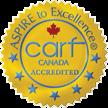
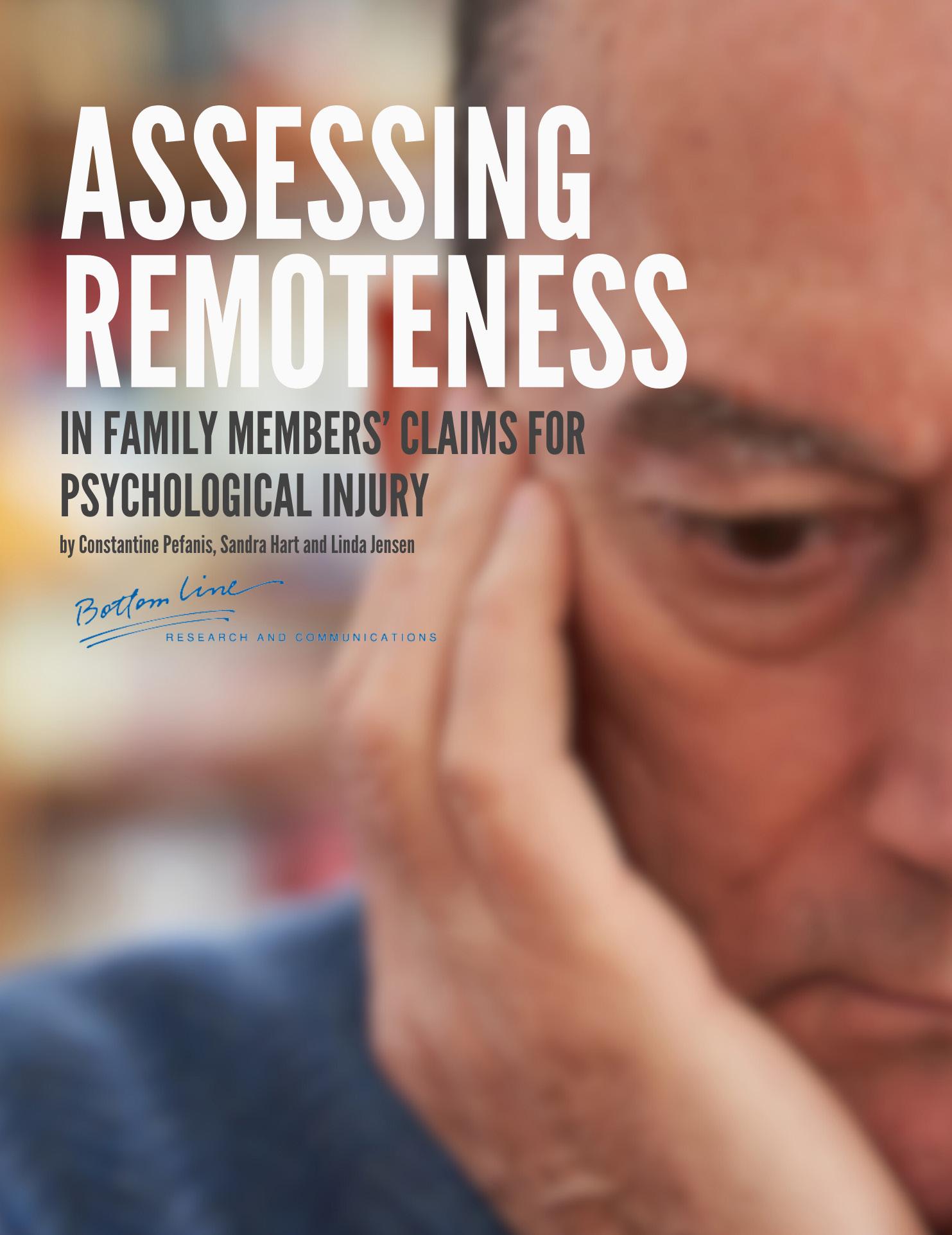

Tort law has historically been cautious in granting relief for injuries to mental well-being. While in modern times the scope for compensation related to psychological injury has expanded beyond the limited sphere that was permitted in the early nervous shock cases, the common law’s concern for open-ended liability continues to be reflected in the case law. In particular, where psychological injury is alleged, remoteness and foreseeability are typically key issues.
Claims by indirect plaintiffs – for example, family members who were not present at the scene of an accident but nonetheless suffer emotional distress or shock as a result of a loved one’s injury – continue to be interesting and challenging cases where the analysis of remoteness and foreseeability is key. Case law indicates that the analysis is factually driven, and there is no “bright line” determining which types of facts will or will not support a successful claim.
Negligence claims for psychological injury have been considered by the Supreme Court of Canada in two prominent cases, Mustapha v. Culligan of Canada Ltd., 2008 SCC 27, [2008] SCJ No 27 and Saadati v. Moorhead, 2017 SCC 28, [2017] SCJ No 28.
In Mustapha, McLachlin CJ confirmed that like any negligence claim, a claim for psychological injury requires that the plaintiff demonstrate 1) that the defendant owed him a duty of care; 2) that the defendant’s conduct breached the standard of care; 3) that the plaintiff sustained damage; and 4) that the damage was caused, in fact and in law, by the defendant’s breach. While McLachlin CJ declined to define compensable injury exhaustively, she noted that it must be serious and prolonged and “rise above the ordinary annoyances, anxieties and fears that people living in society routinely, if sometimes reluctantly, accept” (at para 9).
In psychological injury claims, it is not uncommon for debate to focus in particular around the fourth element of the test – namely, causation in fact and law – where issues of remoteness and foreseeability are addressed. The remoteness issue asks whether the harm is too unrelated to the wrongful conduct to hold the defendant fairly liable. It depends on the degree of probability required to meet the reasonable foreseeability requirement and also on whether the plaintiff’s harm is considered objectively or subjectively.
The law has consistently held that the question is what a person of ordinary fortitude would suffer. In Mustapha, McLachlin CJ explained how distinctions may be drawn between psychological injuries that are foreseeable, and those that are not:
[15] […] the requirement that a mental injury would occur in a person of ordinary fortitude, set out in Vanek, at paras. 59-61, is inherent in the notion of foreseeability. […] As stated in Tame v. New South Wales (2002), 211 C.L.R. 317, [2002] HCA 35, per Gleeson C.J., this “is a way of expressing the idea that there are some people with such a degree of susceptibility to psychiatric injury that it is ordinarily unreasonable to require strangers to have in contemplation the possibility of harm to them, or to expect strangers to take care to avoid such harm” (para. 16). To put it another way, unusual or extreme reactions to events caused by negligence are imaginable but not reasonably foreseeable.


[16] To say this is not to marginalize or penalize those particularly vulnerable to mental injury. It is merely to confirm that the law of tort imposes an obligation to compensate for any harm done on the basis of reasonable foresight, not as insurance. […] Once a plaintiff establishes the foreseeability that a mental injury would occur in a person of ordinary fortitude, by contrast, the defendant must take the plaintiff as it finds him for purposes of damages. As stated in White, at p. 1512, focusing on the person of ordinary fortitude for the purposes of determining foreseeability “is not to be confused with the ‘eggshell skull’ situation, where as a result of a breach of duty the damage inflicted proves to be more serious than expected”. Rather, it is a threshold test for establishing compensability of damage at law. [emphasis added]
The degree of probability that would satisfy the reasonable foreseeability requirement is a “real risk”, one which would occur to the mind of a reasonable person in the position of the defendant and which they would not brush aside as far-fetched (para 13).
In Mustapha, the plaintiff claimed damages for psychological injuries sustained as a result of seeing dead flies in a bottle of water supplied by the defendant. Although successful at trial, the Supreme Court of Canada found a cause of action in negligence had not been established. It was accepted that the defendant’s breach of its duty of care in fact caused the plaintiff’s psychiatric injury. However, at issue was whether the breach also caused the plaintiff’s damage in law or whether it was too removed to warrant recovery. The plaintiff had failed to establish his damage was caused in law by the defendant’s negligence. The plaintiff had failed to show it was foreseeable that a person of ordinary fortitude would suffer serious injury from seeing the flies in the water bottle. His damages were too remote to allow recovery.
Mustapha thus recognized that a duty exists at common law to take reasonable care to avoid causing foreseeable mental injury. The ordinary duty of care analysis is to be applied. It is unnecessary to mandate formal, separate consideration of certain dimensions of proximity. Temporal, geographic and relational considerations might inform the proximity analysis but the proximity analysis is to be sufficiently flexible to capture all relevant circumstances that might in any given case be relevant to determining a close and direct relationship, which is the hallmark of the common law duty of care.
In Saadati, the Supreme Court of Canada confirmed the elements of the cause of action in negligence as well as the threshold for proving mental injury as outlined in Mustapha. Brown J. further confirmed that Mustapha stands for the proposition that recoverability of mental injury depends on the claimant satisfying the criteria applicable to any successful action in negligence and that each of the four criteria can pose a significant hurdle as, for example, not all claimants alleging mental injury will be in a relationship of sufficient proximity with the defendants to ground a duty of care, and not all mental injury is caused, in fact or in law, by the defendant’s negligent conduct:
[20] Mustapha thus serves as a salutary reminder that, even where a duty of care, a breach, damage and factual causation are established, there remains the pertinent threshold question of legal causation, or remoteness -- that is, whether the occurrence of mental harm in a person of ordinary fortitude was the rea-


sonably foreseeable result of the defendant's negligent conduct (Mustapha, at paras. 14-16). And, just as recovery for physical injury will not be possible where injury of that kind was not the foreseeable result of the defendant's negligence, so too will claimants be denied recovery (as the claimant in Mustapha was denied recovery) where mental injury could not have been foreseen to result from the defendant's negligence.
However, Saadati also rejected authorities suggesting that requirements of "relational", "locational", and "temporal" proximity should be formally applied as part of the test for establishing a viable claim:
[16] Further obstacles to recovery for mental injury arose in English law. In McLoughlin v. O'Brian, at pp. 419-21, Lord Wilberforce posited three considerations that could limit the boundaries of compensable "nervous shock": the class of persons whose claims should be recognized (often referred to as relational proximity), the proximity of such persons to the accident (locational, or geographical proximity), and the means by which the "shock" is caused (temporal proximity). [...] […]
[24] […] it is in my view unnecessary and indeed futile to re-structure that analysis so as to mandate formal, separate consideration of certain dimensions of proximity, as was done in McLoughlin v. O'Brian. Certainly, "temporal", "geographic" and "relational" considerations might well inform the proximity analysis to be performed in some cases. But the proximity analysis as formulated by this Court is, and is intended to be, sufficiently flexible to capture all relevant circumstances that might in any given case go to seeking out the "close and direct" relationship which is the hallmark of the common law duty of care […].
Saadati further confirmed that a recognizable psychiatric illness is not a precondition to recovery for mental injury or nervous shock (at para 2).
The principles regarding reasonable foreseeability in negligence cases outlined in Mustapha and Saadati were recently recognized by the Alberta Court of King’s Bench in the medical negligence case of KY v. Bahler, 2023 ABKB 280, [2023] AJ No 486. Renke J. noted that foreseeability is assessed in the circumstances of the defendant. The injury or loss must not simply have been possible but rather, the injury must have been a “real risk”, as described in Mustapha. The issue is whether the class, type, or kind of injury was foreseeable, not the extent of the actual injury or the precise manner of its occurrence (at paras 862-864).
Cases post-Saadati have wrestled with whether or not a claim for psychological injury is sustainable when the claimant was not present at the accident scene. The cases suggest that although refuting remoteness and foreseeability concerns may be challenging, each case turns on its own facts, and successful claims are not precluded.
In Cox v. Fleming, [1995] BCJ No 2499, 15 BCLR (3d) 2011 (CA), the plaintiffs were the parents of an 18-year-


old who was critically injured in a motor vehicle accident and who later died in hospital. Although accepting expert evidence that the father did not suffer from PTSD, the court nonetheless allowed the father ’s claim for psychological injury, finding that the sight of his son so badly injured in the hospital did have a lasting impact on him, and qualified this type of impact as an "emotional scar" that is compensable (at paras 13-15).
In Labrosse v. Jones, 2021 ONSC 8031, [2021] OJ No 6829, the plaintiff claimed for psychological injuries suffered after she was called by her daughter from the scene of an accident in which the daughter was seriously injured. The plaintiff was traumatized by what she heard on the telephone, by her inability to provide assistance to her daughter and by the traumatic nature of her daughter’s injuries. MacLeod RSJ found that foreseeability, whether at the duty of care stage or the remoteness stage, was the key issue. He further found it appeared “far fetched” to include a person phoned by an accident victim in the same class as a person who is present at an accident, noting there is a significant body of case law that has refused to award damages for mental injury to family members who were simply informed of an accident. However, given the “omnipresence of digital communication” and the rejection of arbitrary proximity factors in Saadati, it was difficult to justify a distinction between a plaintiff who was present at an accident and saw or heard it and a plaintiff that was able to hear the accident while connected by a phone. The foreseeability analysis required nuanced findings of fact that were genuine issues best resolved at trial, sufficient to defeat the defendants’ motion for summary judgment.
In Snowball v. Ornge, 2017 ONSC 4601, [2017] OJ No 3932, Faieta J. found it was not plain and obvious that the plaintiffs’ negligence action seeking damages for mental distress as a result of the death of their family member in a helicopter action had no reasonable prospect of success and also refused to summarily dismiss the action. Given that Saadati rejected the distinction between primary and secondary victims and the view that there are geographic, temporal and relational proximity restrictions that are an absolute limitation on the duty to take reasonable care to avoid causing foreseeable mental injury, the plaintiffs’ claims for mental distress might succeed even though they were secondary victims who did not witness the accident. The outcome of the action would turn on the robust application of the elements of an action in negligence by the trier of fact rather than on the separate application of geographic, temporal, and relational considerations or a distinction between primary and secondary victims.
In Stroup v Klaassen, 2023 BCSC 1944, [2023] BCJ No 2129, Brongers J dismissed an application to summarily dismiss the plaintiffs’ claim for negligent infliction of mental injury claim arising from the death of their daughter in a motor vehicle accident. The parents attended at the hospital and saw their daughter, unconscious in the intensive care unit, before she passed away. Brongers J found that there was no “bright line” permitting the viability of the plaintiffs' claim to be decided fairly by means of a summary trial:
[53] […] a review of the jurisprudence discussed above reveals that the facts of this case may or may not establish that the defendants owed a duty of care to the plaintiffs. […] Each case, of course, turned on its own unique set of facts, and I am unable to discern any "bright-line" regarding where, when, and how a plaintiff can be said to have experienced compensable mental injury from seeing their relative after an accident caused by a defendant. [emphasis added]
By contrast, in Devji v Burnaby (District), 1999 BCCA 599, 70 BCLR (3d) 42, leave to appeal refused [1999] SCCA No 608, File No 27667, the court granted summary dismissal of claims for psychological injury brought


by the parents and sisters of a woman who had been killed in a motor vehicle accident. The plaintiffs claimed to suffer the injuries at the hospital where they had been asked by the police to identify the body. In rendering judgment, however, the court recognized that locational proximity sufficient to ground a claim is not limited to just being at the scene of an accident but may extend to seeing its "immediate aftermath", such as at a hospital (at para 67).
In Toukaev v. Insurance Corp. of British Columbia, 2011 BCCA 87, [2011] BCJ No 288, a pre-Saadati case, the plaintiff was also unsuccessful in his claim for nervous shock arising from hearing of his wife’s accident and seeing her in a very bad state at the hospital 40 to 50 minutes after the accident. The Court of Appeal found that as the plaintiff had learned of his wife’s injuries before he saw her, and while her condition must have been upsetting to him when he saw her, it could not be said to have been unexpected. The plaintiff’s claim did not fall within the requirements of the law relating to the circumstances in which persons who were not physically injured were entitled to damages for nervous shock. That aspect of his appeal lacked the degree of merit necessary to justify a finding of indigent status for his appeal.
In Bevan v. Husak, 2023 BCSC 304, [2023] BCJ No 375, the plaintiff claimed damages for negligent infliction of mental distress. The plaintiff alleged she suffered a nervous shock when she attended the defendant’s residence to pick up her daughter, who had stayed overnight, and found out she was not there. The daughter arrived home within a few hours and disclosed that the defendant had provided her with alcohol and had sexual intercourse with her. The situation had a profound impact on the mental health of both the daughter and the plaintiff.
Betton J. noted that it is often difficult to predict the cases in which liability will be imposed in claims for nervous shock. The claim for nervous shock must be for actual psychiatric or emotional injury caused by, not just resulting from, the actionable conduct of the defendant. In other words, the injury must arise from exposure to the defendant’s negligence, not from consequences that resulted from that negligence. Temporal proximity, the relation in time between the defendant’s conduct and the onset of the psychiatric illness, is used in assessing foreseeability because it evidences the connection between the conduct and the injury:
[57] […] the plaintiff in a cause of action for nervous shock must witness the defendant’s conduct or its aftermath. That aftermath may include attending almost immediately at the hospital for the purpose of identifying the body of [a] deceased relative. However, what falls within the scope of aftermath is limited. Sufficient temporal and location proximity must be present. The harm must be caused by the defendant’s conduct, rather than resulting from it.
In Bevan, Betton J found that the plaintiff was effectively asserting her psychiatric response resulted from the defendant’s conduct as opposed to being caused by it. There was insufficient proximity to establish a duty of care between the parties. The claim failed to disclose a reasonable cause of action.
In Rowe Estate v. Hanna (1989), 102 AR 88, [1989] AJ No 1046, another pre-Saadati case, the mother claimed damages for nervous shock following the death of her 18-year-old daughter in a motor vehicle accident. The mother had not been present at the accident and learned of her daughter’s death within an hour or two, upon attending at the hospital and being informed by doctors. Forsyth J. acknowledged that the determination of the mother’s claim was dependent on a consideration of foreseeability. He concluded the mother’s shock was not


reasonably foreseeable because she was not at the accident scene and only learned of the accident later from third parties.
However, in Leckie Estate v. Stevenson (1997), 56 Alta LR (3d) 431, [1997] AJ No 439, which arose from a claim for nervous shock brought by the parents and sisters of a man killed in a motor vehicle accident, Master Funduk refused to find that Rowe had narrowed foreseeability to situations where the victim observes an accident or sees the body a short time after the accident. He noted that: “Foreseeability is not a question of law. It is a question of fact, or the conclusion to be drawn from the facts. A conclusion based on the evidence cannot be or become a rule of law.” Master Funduk therefore dismissed the defendant’s application to strike portions of the pleadings dealing with the claims for nervous shock (at para 11).
In Brown (Next friend of) v. University of Alberta Hospital (1997), 145 DLR (4th) 63, [1997] A.J. No 298, the mother claimed damages for nervous shock against the defendant medical professionals who failed to report the suspected abuse of her infant daughter. The daughter had been brought to the hospital on two occasions by her father, who claimed on both occasions she had fallen. The daughter sustained severe and permanent brain damage. Marceau J. found the mother was clearly within a class of persons to be compensated, as she saw the aftermath of the injuries sustained by the child. She had suffered from stress-related headaches, back problems, and depression. However, the expert medical evidence failed to state the cause of the mother’s mental shock. Marceau J. concluded the cause was the mother’s grief at the plight of her child and the terrible pressures of dealing with the child’s needs and care, which was not compensable in Alberta. The court found that nervous shock was not the immediate cause of the mother’s mental injuries.
As these decisions illustrate, claims brought by family members and other indirect plaintiffs seeking compensation for emotional and psychological distress are not barred as a matter of law. Rather, their success turns on examination of the specific factual circumstances, which will often make them unsuitable for summary determination. Courts evaluating such claims can be expected to look closely at factors related to the proximity of the psychological harm to the accident itself, the foreseeability of psychological injury to indirect plaintiffs, and the extent to which the harm was caused by, rather than merely the result of, the defendant’s conduct. RESEARCH

PHONE: ( 403 )688-2119
linda@bottomlineresearch.ca

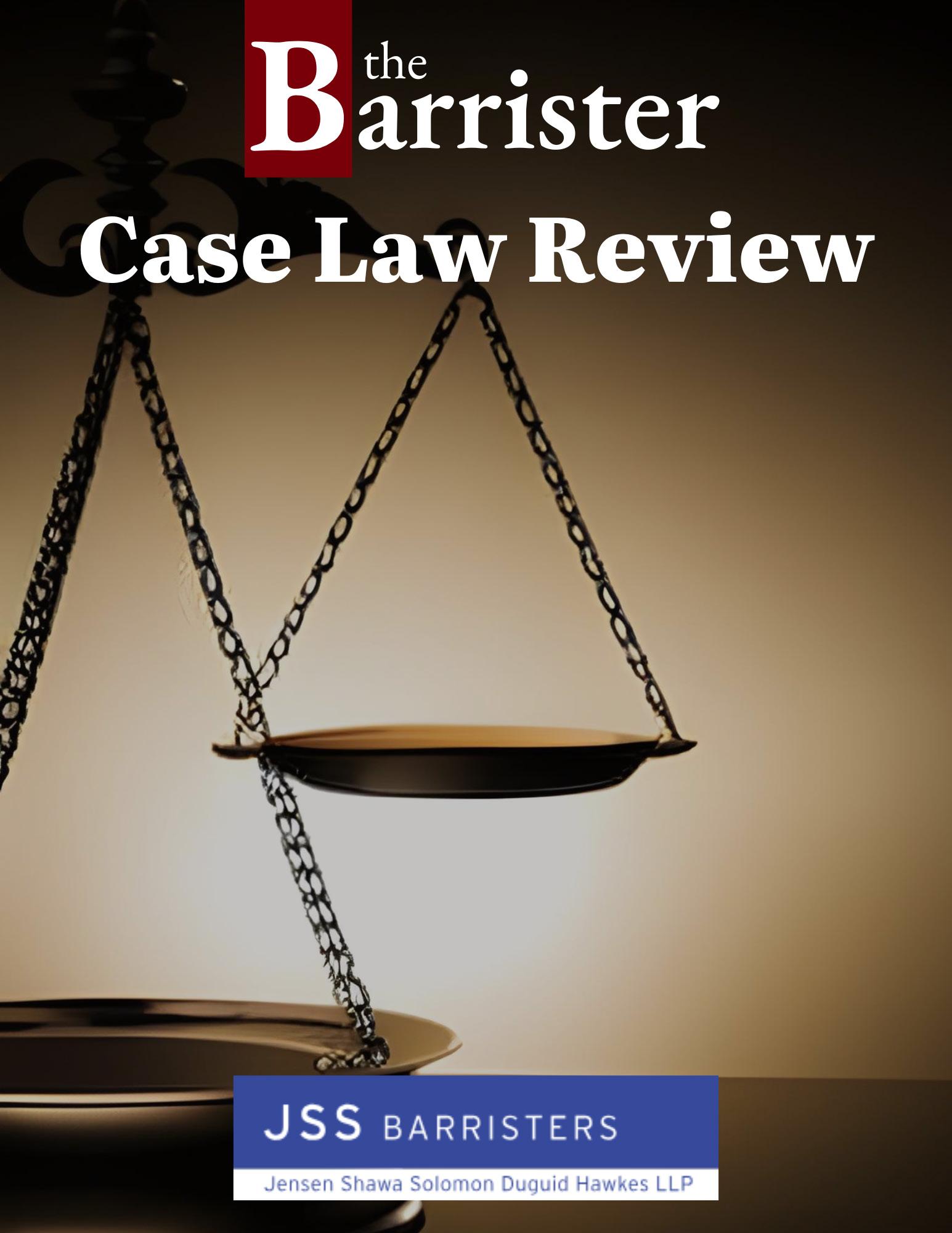


No part of this database, and the contents therein, may be reproduced without the prior written consent of JSS Barristers. JSS Barristers and all individuals involved in the preparation and publication of JSS Barristers Rules make no representations as to the accuracy of the contents of this database. This database, and the contents herein, are provided solely for information and do not constitute legal or professional advice from JSS Barristers or its lawyers.
Rules 1.2 (Purpose and Intention of These Rules), 5.7 (Producible Records), 5.8 (Producible Records for Which There is an Objection to Produce), 5.11 (Order for Record to be Produced), 6.44 (Persons Who Are Referees), 6.45 (References to Referee), 6.46 (Referee’s Report) and 10.29 (General Rule for Payment of Litigation Costs)
The Plaintiffs sought an Order directing the Defendant companies to provide a further and better Affidavit of Records, to pay unpaid Cost Awards, and to answer outstanding Undertakings. The Defendants had bundled their Affidavit of Records, and argued that their bundling of records was no different than the common practice under Rule 5.8 of bundling the contents of a lawyer ’s file when asserting a claim of privilege The Plaintiffs acknowledged that the Rules permit groups of records to be bundled pursuant to Rule 5.7 but argued that the Defendants’ bundling practice did not provide “sufficient detail to enable another party to understand what it contains” pursuant to Rule 5.7(2)(b). Justice Feasby held that the adequacy of the descriptions is inextricably linked to whether the records are “all of the same nature”, as required by Rule 5.7(2)(a), which had never been judicially considered in Alberta.
The Plaintiffs argued that records “of the same nature” should be interpreted to mean that they are the same type or class of record and should be from a defined period, and that this is consistent with the purpose and intention of the Rules as provided by Rule 1.2. The Court held that given the longstanding practice in Alberta of bundling records from a common source, “I cannot read ‘same nature’ as to restrict the practice of bundling only to situations where there is the same type or class of record such as bank statements or invoices.” The Court held that the approach to describing bundles must be adjusted depending on the context, and that the principle of proportionality that governs production equally applies to description of bundles. Where a bundle is compromised of homogenous records, a terse description is all that is needed, whereas the more heterogeneous the contents of a bundle, the more robust the description that is required. As the bundles before the Court contained a mix of different types of records, a more thorough description was required, and the Court ordered the Defendants to provide bundle descriptions with sufficient detail to enable the Plaintiffs to understand what each bundle contains.
The Plaintiffs also applied pursuant to Rule 5.11 for an Order compelling the Defendants to disclose records that the Defendants had asserted privilege over. After reviewing the law on solicitor-client privilege and litigation privilege, the Court held that the descriptions of the bundled documents provided by the Defendants did not appear to fall under either category. While the Court may review the records to assess the privilege claim pursuant to Rule 5.11(2)(a) or a referee may be appointed to inspect the records pursuant to Rules 6.44-6.46, Feasby J. ordered the Defendants to review the records “with the benefit of these Reasons” and ordered that any change must be reflected in the updated Affidavit of Records.
The Court also found that the Defendants had failed to comply with a previous Court Order to produce Undertakings. Justice Feasby ordered the Defendants to provide the Undertakings in the updated Affidavit of Records.

Finally, with respect to outstanding Costs, the Court noted that one outstanding Costs Award was due within 30 days of the Order and the other Costs Award was silent on timing. After noting that the unsuccessful party must pay Costs forthwith pursuant to Rule 10.29(1), Feasby J. held that a further Order for the Defendants to pay Costs added nothing to the existing directions. Accordingly, Justice Feasby held that the Plaintiffs were permitted to pursue enforcement proceedings in respect to the unpaid Costs.
Rules 1.2 (Purpose and Intention of These Rules), 4.31 (Application to Deal with Delay) and 4.33 (Dismissal for Long Delay)
The Applicant in divorce proceedings applied for, among other things, a dismissal of the Respondent’s June 2017 Application to vacate arrears of child support (the “June 2017 Application”) for delay in accordance with Rules 4.31 and 4.33.
The Court reviewed the jurisprudence for Rules 4.31 and 4.33 and found that it was clear that the delay rules apply to divorce and other family law proceedings and although Rule 4.33 is mandatory, Courts in Alberta have repeatedly chosen not to apply the delay Rules on Applications under the Divorce Act, RSC 1985, c 3.
The Court accordingly noted that although more than three years had passed without a significant advance in the June 2017 Application, it declined to dismiss for long delay for the following reasons: (1) the ability of the Respondent to restart the Application would not prevent her from initiating a fresh Application and restarting the process again; (2) the principle of res judicata does not extend to Applications that are dismissed for long delay; (3) dismissing for delay when the Respondent could simply restart the process would not be in the interests of justice, with reference to Rule 1.2; and (4) either party could have set the June 2017 Application down for further adjudication, and it would accordingly run counter to the fundamental principles of parental support obligations to dismiss the June 2017 Application.
BRISTOL-MYERS SQUIBB CANADA CO V GRAND PRAIRIE (CITY),
Rules 1.2 (Purpose and Intention of These Rules), 3.26 (Time for Service of Statement of Claim), 3.27 (Extension of Time for Service) and 9.15 (Setting Aside, Varying and Discharging Judgments and Orders)
The Defendant appealed a Decision of the lower Court extending the time for service of a class action Statement of Claim by three months. The Order was granted by an Applications Judge ex parte. The Defendant applied to an Applications Judge to set aside that Order, pursuant to Rule 9.15(4). That Application was denied. The Decision of the Applications Judge was then appealed to a Chambers Justice. That Appeal was also dismissed. The Defendant then appealed the Chambers Justice’s Decision to the Court of Appeal.
On the initial Appeal before the Applications Judge, the Defendant argued that the necessary threshold had not been met to justify extension of service, and that there had not been full, fair, and candid disclosure of the relevant facts. The Applications Judge found that the Application filed with the initial Application had been sufficiently fulsome, and exceeded the bare minimum requirements to justify an extension.
The Chambers Justice then considered the matter de novo on Appeal. The Court concluded that the delays in service were the result of solicitor negligence. However, on review of the law relating to solicitor negligence and Rules 3.26 and 3.27, the Court found that delay caused by solicitor negligence does not preclude an ex-


tension. Citing Rule 1.2, the Chambers Justice added that setting aside service might cause a proliferation of actions and complicate and delay the existing class action, which would not serve the purpose and intention of the Rules. The Court consequently dismissed the Appeal.
On Appeal to the Court of Appeal, the Appellants argued that the Chambers Justice overlooked gaps in the evidence regarding efforts to serve each Defendant, and created a new and problematic “solicitor’s negligence” exception to Rule 3.26. The Court declined to comment on the issue of solicitor’s negligence as a principle, but found that the solicitor had not been negligent, as the extension had been sought before expiry of the service period. It then focused on the sufficiency of the evidence before the Applications Judge at the without notice hearing, finding that it was open to the Applications Judge and Chambers Justice to find that the evidentiary record sufficiently supported the Application. Therefore, there was no error in law or principle in granting the extension, and the Appeal was dismissed.
Rules 1.4 (Procedural Orders), 4.22 (Considerations for Security for Costs Order), 5.2 (When Something is Relevant and Material), 5.25 (Appropriate Questions and Objections), 5.31 (Use of Transcript and Answers to Written Questions), 5.33 (Confidentiality and Use of Information), 6.7 (Questioning on Affidavit in Support, Response and Reply to Application), 6.11 (Evidence at Application Hearings), 6.14 (Appeal from Applications Judge’s Judgment or Order), 6.29 (Restricted Court Access Applications and Orders) and 8.12 (Exclusion of Witnesses)
Pursuant to Rule 6.14, the Plaintiff appealed an Applications Judge’s Decision dismissing her Application to exclude the Defendants from attending at each other ’s Questioning on Affidavits, filed in support of the Defendants’ Security for Costs Applications (the “Exclusion Application”). In dismissing the Appeal, Marion J. set the out the applicable framework for excluding a party from attending the Questioning on Affidavit of another party in the same Action.
The claim arose from a surgical procedure involving several Defendants comprised of doctors, their professional corporations, and the center at which the procedure took place.
Before the Applications Judge, the Plaintiff tendered cases supporting the proposition that the Court can exclude Defendant parties from each other’s Questioning if there is an apprehension of misconduct based on “cogent evidence of tailoring or harmonization of evidence”. However, the Defendants distinguished the Plaintiff’s line of cases based on the fact that they dealt with Questioning for discovery, not Questioning on Affidavits.
The Defendants argued that Questioning on Affidavits was akin to a Trial and as such, by analogy, Rule 8.12 was engaged. Rule 8.12 addresses the exclusion of witnesses and parties at Trial. The Defendants urged the Applications Judge to apply a line of cases from Ontario that addressed the exclusion of witnesses. However, the onus under these cases was more onerous.
Before setting out the applicable framework, Marion J. reviewed the case law related to the exclusion of parties from Questioning for discovery and Trials.
Justice Marion noted that Applications for exclusions of parties from Questioning for discovery “occur with some frequency in Alberta and other provinces”. However, the Rules do not specifically provide for excluding a party from Questioning for discovery. Nonetheless, the Court has discre-

tion to exclude parties under Rule 1.4, the case law, and section 8 of the Judicature Act, RSA 2000, C J-2. Rule 1.4 gives the Court broad procedural discretion to ensure the fair and expeditious determination of an Application or proceeding.
The Court found that the Alberta case law was clear that the Applicant must justify an exclusion. The focus of the inquiry is on the integrity of the legal process. The general test is “whether exclusion is necessary for the fair and proper judicial conduct of the action”. The Applicant must establish that there is a “reasonable apprehension of misconduct or prejudice which, without an order, will defeat the object and purpose of the discovery questioning”. The test is applied to the specific circumstances of each case in light of various factors. For example, the Court will analyze the “impacts of the decision to exclude or not exclude on the party sought to be excluded, the party seeking exclusion, the person testifying, the functioning of the discovery process itself, and the impact on the action more generally”.
Next, the Court turned its attention to the test for excluding parties from Trial. Generally, it is more difficult to exclude a party from attending at Trial than at Questioning for discovery because the Trial represents the final resolution of the parties’ rights.
Under the previous Rule 247, the Court could exclude a witness from Trial irrespective of whether the witness was a party or not. However, Rule 8.12 restricted the Court’s jurisdiction to exclude parties; and under Rule 8.12(3), a party may be excluded only if it interferes with the Trial process.
Lastly, Marion J. reviewed whether parties can be excluded from Questioning on Affidavit. Rule 6.7 stipulates that a person who makes an Affidavit can be questioned by any person adverse in interest. The Court has discretion to order an exclusion; however, Applications to exclude a party from Questioning on Affidavit are rare. In reviewing the case law, Marion J. noted some crucial distinctions between Questioning for discovery and Questioning on Affidavit. Questioning for discovery is private and subject to the implied undertaking rule at common law and under Rule 5.33. Further, transcripts from Questioning for discovery are not filed. Rules 5.31 and 6.11(c) stipulate that the questioning party may nonetheless use Questioning for discovery transcripts, or portions of them, as “read-ins”, at Trial or in support of an Application against a party adverse in interest. On the other hand, transcripts from Questioning on Affidavit must be filed under Rule 6.7(b). Further, if an Applicant wants to exclude a party from attending another party’s Questioning on Affidavit, it would most likely have to apply for a restricted Court access Order under Rules 6.29 and surrounding Rules, or seek an injunction prohibiting the party from reviewing publicly available documents.
Lastly, Rule 5.25 outlines the scope of questions allowed at Questioning for discovery. A party is required to answer questions that are “relevant and material”. As per Rule 5.2, a question is “relevant and material” if its answer significantly helps to determine an issue in the Pleadings. On the other hand, the scope of questions at Questioning on Affidavit is limited to questions that are “relevant and material” to the issues raised in the underlying Application.
Justice Marion held that a more nuanced approach is required to exclude a party from Questioning on Affidavit. There are four principles that come into play. First, a party has the right to be present under Rule 6.7 unless excluded by the Court. The right to be present is particularly strong where the Application is for final relief. Second, the Applicant bears the onus to establish an evidentiary foundation justifying exclusion. Third, the general test is whether the exclusion is necessary for the fair and proper judicial conduct of the Action, with the focus being on the integrity of the legal process. Fourth, the general test is met where “reasonable apprehension of misconduct or prejudice which, without an order, will defeat the object and purposes of questioning on affidavit”.


Additional factors that are relevant in the context of Questioning on Affidavits include: (a) the nature of the underlying Application (where an Application involving final relief counts against the exclusion of a party); (b) the degree to which the apprehension or risk of evidence tailoring is mitigated by the fact that the Affiants have already attested to facts; and (c) whether the exclusion will actually address the concerned mischief (little is achieved through exclusion if the evidence of the parties has already been fully explored in Questioning for discovery or previous Questioning on Affidavits).
Justice Marion determined that the Exclusion Application was in the context of Security for Costs Applications, which involve a two-step process. First, the criteria in Rule 4.22 must be met. Second, the Court must ask whether it is just and reasonable to grant security. Security for Costs Applications are not final Orders but can end an Action. Therefore, the Defendants’ rights were not in jeopardy as they would be at Trial or on a Summary Judgment Application.
In considering the state of the Action and evidence, Marion J. found that little would be gained by excluding the Affiants from each other’s Questioning because Questioning on their Affidavits already took place and the transcripts had been filed and made public.
Based on the parties’ submissions and the record, there was no reasonable apprehension of evidence tailoring or misconduct by the Defendants. Further, an Order was not necessary for the fair and proper judicial conduct of the Action.
Rules 1.5 (Rule Contravention, Non-Compliance and Irregularities), 3.2 (How to Start an Action) and 3.8 (Originating Applications and Associated Evidence)
The Plaintiff brought an Application upon receipt of a filed Application and Affidavit (the “Underlying Application”) corresponding to a Fiat relating to the Underlying Application, to: (1) set aside the Fiat; (2) require the Defendant to file the same Application using a different form; (3) and for any new Application to be dated on the actual date of any such future filing. The Defendant brought a cross Application for an Order that the Fiat backdating the Underlying Application in the original form be validated (the “Cross Application”). The Underlying Application was required to be filed within the one-year period (the “One-Year Period”). set out in Article 12 of the Hague Convention on the Civil Aspects of International Child Abduction (the “Hague Convention”).
The Defendant had requested the Fiat for the Underlying Application under the Hague Convention which was granted.
Among other things, the Court noted how Practice Note 6 indicates that the party seeking an Order directing the return of the child must file an Originating Application (Form 7) pursuant to Rule 3.8 and a supporting Affidavit. The Plaintiff advanced an argument setting out that Practice Note 6 was directive and that any corrective discretion given to a Justice pursuant to Rule 1.5 could not backdate the date of the actual filing of the Underlying Application, as to do so would have the effect of prejudicing the Plaintiff. Conversely, the Defendant argued that Rule 1.5 could be used to remedy any shortfall or noncompliance with the Rules, noting these were not circumstances where the Underlying Application or its contents were unknown to the Plaintiff until after the One-Year Period had expired, and therefore no one had been prejudiced.


The Court set out Rule 3.2(6), which sets out how to bring an Action. The Court noted that the Court of Appeal had indicated that Practice Notes do not have the full force of law but are rather informational statements for guidance and that Courts should always attempt to support them as they are set out to facilitate the proper regulation of litigation. The Court additionally noted that the directive words in Practice Notes are often overcome by the use of Fiats and are distinguishable from circumstances where there is express directive language in legislation. Accordingly, the Court found that it was able to relieve against the incorrect form.
Among other things, the Court acknowledged that although the Defendant had sought the Fiat, the Defendant was in error by failing to (1) provide a complete history; (2) clarify that the notice to the Plaintiff had been provided the same morning the Fiat was sought; (3) identify or highlight the issue of the form of the Application; and (4) explain the effect of the One-Year Period.
The Court additionally noted that the Court had wrongly assumed that the Plaintiff consented 18to the Fiat from the brief introduction provided by the Defendant, which included the fact that a hearing had been set in February and that notice had been provided. The Court accordingly found that the Defendant had not made an intentional misrepresentation, such that the administration of justice should not support consideration of curing the non-compliance.
The Court found that the curative action would not be prejudicial or cause irreparable harm such that it would be prevented under Rule 1.5(4)(a), and the curative powers of Rule 1.5 could be applied. The Court accordingly granted the Defendant’s Cross Application.
MCDONALD V SPROULE MANAGEMENT GP LIMITED, 2023 ABKB 587 (MARION J)
Rules 1.7 (Interpreting these Rules), 5.26 (Transcript of Oral Questioning), 5.30 (Undertakings), 5.32 (When Information May be Used), 6.7 (Questioning on Affidavit in Support, Response and Reply to Application), 6.11 (Evidence at Application Hearings), 6.20 (Form of Questioning and Transcript), 7.3 (Summary Judgment) and 13.18 (Types of Affidavit)
The Plaintiff applied for Summary Judgment in respect of a claim for wrongful dismissal against the Defendant.
Among other issues, the Court considered what constituted a transcript that must be filed pursuant to Rule 6.7. The Court noted that the Defendant filed a Court reporter generated transcript of the Questioning on the Plaintiff’s Affidavit but did not include with it the exhibits that were marked, other records put to the Plaintiff during Questioning but not marked as exhibits, or the Plaintiff’s responses to Undertakings (or attached records) given during the Questioning.
The Court set out Rules: 6.20(5), as it relates to the obligation of the Questioning party to arrange for the Questioning to be recorded and the transcript filed; 6.20(3), as it relates to the requirements of recording of the questions and answers; 6.11(b), as it enables the Court to consider a transcript of Questioning under Part 6 of the Rules in deciding an Application; and Rule 13.46, as it relates to the obligations of the official Court reporter.
The Court noted that although Part 6 of the Rules is silent as to whether exhibits marked by the official Court reporter during a Questioning on an Affidavit under Rule 6.7 are part of the transcript, the principles from Rule 5.26(3) and 5.32 apply by analogy pursuant to Rule 1.7(2). The Court

accordingly found that absent agreement of all parties or other Court Order, the questioning party must file with the Questioning transcript any marked exhibits (whether numbered or lettered exhibits for identification).
The Court determined that the documents referenced in a Questioning on an Affidavit but not marked as exhibits do not form party of the transcript unless otherwise agreed or ordered by the Court. The Court noted that the parties are encouraged to reach agreement on the matter as it is a common practise consistent with the expediency and efficiency, which will often be consistent with Rule 1.2. The Court further noted that any such agreement should be put on the record to avoid misunderstanding or disputes and expressly reference the parties’ agreement that those records are to be treated as exhibits to, or otherwise part of, the transcript.
The Court reviewed Rule 5.31 noting that it provided that in certain circumstances, a party may use (read-in) the evidence of the other party under Rule 5.17 and 5.18, but that Part 5 does not specifically address whether Undertaking answers form part of the transcript of Questioning. After noting that there was an issue as to whether Undertaking answers must be questioned upon under Rule 5.30(2) in order for them to form part of the Part 5 Questioning transcript, the Court determined that Undertaking answers form part of the transcript whether or not they are questioned upon. The Court determined that although Rule 5.30 does not technically apply to Questioning under Part 6, it applies by analogy pursuant to Rule 1.7(2), as modified by the jurisprudence which restricts its use in Questioning on an Affidavit. The Court additionally noted that there was no principled basis to differentiate between Part 5 and Part 6 Questioning when determining what forms part of the transcript.
The Court accordingly found that: (1) unless otherwise agreed or ordered by the Court, Undertaking answers form part of the transcript to a Questioning on an Affidavit pursuant to Rule 6.7 and should be filed with the transcript; (2) records produced as part of the Undertaking answers should be filed as part of the transcript where they form an integral part of a substantive factual answer to the question asked, but do not need to be filed where they are only produced in response to an Undertaking request to produce records; and (3) if the questioning party wishes to have records produced pursuant to Undertakings form part of the evidentiary record, they should conduct a follow-up Questioning on the Undertaking answers and associated records. The Court also noted that parties may apply to have Undertaking responses including additional superfluous, inappropriate, or non-responsive information struck from the record by arguing that they should be given little or no weight, or by questioning on them. The Court additionally set out that parties are encouraged to discuss and reach agreement on the contents of the transcript to be filed pursuant to Rule 6.7 wherever possible.
The Court determined that the Plaintiff’s Undertaking responses were to be filed as part of the Plaintiff’s transcript and set out that certain records produced as part of the Undertaking answers that were integral to the answer of a substantive factual question that was asked, were to be included with the filed transcript.
The Court set out Rules 7.3(1)(a) and 7.3(1)(c), noting that they enabled a Plaintiff to apply for Summary Judgment and reviewed the jurisprudence applicable to Summary Judgment. In reviewing the evidentiary tools appropriate to Summary Judgment, the Court set out that Applicant Affidavits should generally be based on personal knowledge with respect to Rule 13.18, but noted that some evidence not based on personal knowledge can be admitted with respect to the application of Rule 13.18(3). The Court further noted that Respondent Affidavits may include hearsay evidence based on information and belief, provided the source of the information is disclosed, with reference to Rules 13.18(1)(b) and 13.18(2).
The Court determined that: the Plaintiff had discharged its threshold burden to provide the factual elements of the case; there was no merit to the Defendant’s just cause defence which resulted in the Court determining that the Defendant had not established a genuine issue requiring a Trial; and it was possible and appropriate to resolve the Plaintiff’s claim summarily. The Court found that the Defendant did not have just cause to terminate


the Plaintiff without notice. The Court further found that there was no genuine issue requiring Trial and it was fair to summarily resolve: the Plaintiff’s notice period, the Defendant’s mitigation defence, and the calculation of the Plaintiff’s damages.
Rules 2.29 (Withdrawal of Lawyer of Record), 11.22 (Recorded Mail Service), 11.26 (Method of Service Outside Alberta) and 11.27 (Validating Service)
The Plaintiff was subject to an Order requiring her to seek leave from the Court to continue three Actions due to her prior participation in frivolous and vexatious litigation alongside her father. The Order required the Plaintiff to seek such leave within six months, failing which the Defendants were permitted to apply to strike out the Plaintiff’s claims. The Plaintiff did not seek leave to continue the Actions, and this Decision dealt with the validity of service by the Defendants of their joint Application to strike the Plaintiff’s Claims.
The Plaintiff had originally been represented by counsel in these Actions. The Plaintiff’s counsel withdrew from the record in accordance with Rule 2.29, and in doing so provided a last known residential address for the Plaintiff in South Carolina, as well as the Plaintiff’s email address.
In considering whether the Plaintiff was properly served with the present Application, the Court noted Rule 11.22, which permits service of a non-commencement document by recorded mail, addressed to the party at the address for service provided in the most recently filed document in the Action. Rule 11.22 deems service effective on the earlier of the date on which receipt is acknowledged, or seven days after the recorded mail is sent (regardless of an acknowledgement).
The Defendants sent a copy of the Application materials to the South Carolina address by recorded mail; the package was not able to be delivered to the Plaintiff, nor was it picked up pursuant to the instructions which were left at the South Carolina address.
The Court first dealt with the issue of whether service under the Hague Convention on Service was required. Citing Rule 11.26, Justice Eamon held that it was not, since the Application was not a commencement document.
Next, the Court considered whether the South Carolina address was the appropriate address at which to serve the Plaintiff. Justice Eamon found that the Defendants were entitled to rely on the address listed on the Notice of Withdrawal in accordance with the obligations of counsel under Rule 2.29. This conclusion was not affected by the subsequent filing of documents by the Plaintiff’s father, which documents were later struck as amounting to an abuse of process.
Lastly, Justice Eamon considered whether service was defeated because the package was never picked up. Justice Eamon held that, pursuant to Rule 11.2, service by recorded mail is not invalid only by reason that the addressee refuses to accept the mail or no longer resides 21or is otherwise not present at the address. The Court emphasized the importance of the ability for litigants to rely on the address for service that is given and the methods for service under the Rules. The Court therefore concluded that service was effective under Rule 11.22 and should be deemed good and sufficient under Rule 11.27.

In the result, Justice Eamon struck the Plaintiff’s claims as being an abuse of process further to the earlier Order of the Court.
ABKB 659
(MARION J)
Rules 3.68 (Court Options to Deal With Significant Deficiencies) and 13.18 (Types of Affidavit)
The Applicant Defendants applied for Summary Dismissal of the Plaintiffs’ claim against certain Defendants (the “Summary Dismissal Application”). The Plaintiffs opposed the Summary Dismissal Application and applied to strike portions of the Defendants’ Affidavits (the “Striking Application”). The Court was asked to determine whether any portion of the Defendants’ Affidavits should be struck prior to the Summary Dismissal Application.
The Court set out the prevailing principles for Summary Judgment and the evidentiary screening principles in the context of Summary Judgment Applications. Further, the Court noted that it had jurisdiction to engage in evidentiary screening pursuant to Rule 3.68(4). The Court then reviewed the evidentiary principles related to Affidavit evidence and addressed the Plaintiff’s grounds for the Striking Application, i.e., argument, conclusion (fact), conclusion (law), opinion, and hearsay.
With respect to hearsay, the Court cited Rule 13.18(3) and noted that an Affidavit used in support of an Application should generally be based on personal knowledge. Although there is some flexibility when applying Rule 13.18(3) in Summary Judgment Applications to admit evidence not based on personal knowledge, hearsay should only be admitted if it would be admissible at Trial, or if it meets the requirements for a principled exception to hearsay.
After applying the evidentiary principles to the impugned Affidavits, the Court struck certain portions of the Defendants’ Affidavits.
Rule 3.68 (Court Options to Deal With Significant Deficiencies)
The Appellants appealed a Chambers Judge’s earlier Decision declining to strike an Amended Statement of Claim. The Appellants were individual Defendants and officers of a company. The Appellants previously filed an Application to strike under Rule 3.68 on the basis that it disclosed no reasonable claim as against them in their personal capacities. The Respondents filed a cross-Application to file the Amended Statement of Claim. Both Applications were heard together, and initially, the cross-Application was granted.
The Application’s Judge had dismissed the Application to strike noting that the law on concurrent liability of employees, officers, and directors for torts committed in the course of their employment is unsettled. The Appellants appealed to the Court of King’s Bench.
The Chambers Judge then dismissed the Appellants’ Appeal, noting that it was not obvious whether the proposed amendments to the Statement of Claim disclosed any triable issue or whether the Appellants could be held personally liable for their actions.
On Appeal, the Court of Appeal then considered the factors that determine whether an individual can be held personally liable as a concurrent tortfeasor to a corporation, including the nature of the tort and whether it was intentional. The Court agreed with the Chambers Judge that it was not clear whether the Appellants could be held personally liable, and that the claims outlined in the Amended Statement of Claim should not be struck against the individual Defendants. The Appeal was ultimately dismissed.


Rules 4.14 (Authority of Case Management Judge), 4.31 (Application to Deal with Delay) and 4.33 (Dismissal for Long Delay)
This Decision arose from case management proceedings involving the Defendant and a series of related lawsuits. The case management protocol in place mandated that a party must seek permission to bring an Application against parties in the case management proceedings.
The Defendant applied for a Fiat to proceed with an Application to strike the Plaintiff’s Claim for delay and for a Fiat to proceed with an Application for Summary Trial. Justice Graesser declined both.
With respect to the Application to strike for Delay, Graesser J. identified several issues, and held that the Application lacked a reasonable chance of success.
First, the Defendant’s success would depend on whether her Counterclaim could be severed from the Plaintiff’s Statement of Claim. Justice Graesser was unaware of Alberta cases where the Plaintiff’s claim was struck for delay yet the Defendant’s Counterclaim was allowed to proceed. The claim and Counterclaim are joined, and one step in one would move the entire Action towards Trial.
Second, the Defendant had previously obtained an Order staying the running of time under Rules 4.31 and 4.33. Rule 4.31 provides that an Action should be dismissed where delay causes significant prejudice to a party. Rule 4.33 provides that an Action must be dismissed if three or more years have passed without a significant advance in the Action. The Order was granted in case management pursuant to Rule 4.14, which provides Case Management Judges with broad powers to resolve issues in the litigation. The Order provided for a suspension period under Rules 4.33(2)(a) and 4.33(9), which caused the time to stop running against both parties.
Further, there was delay from the transition of case management from various Judges to Graesser J., for which neither party would be responsible.
Lastly, the Plaintiff’s Statement of Claim sought a declaration that it no longer had a duty to defend or indemnify the Defendant. Even if the Plaintiff’s Statement of Claim would be struck for delay, the Plaintiff would not lose the ability to maintain its position. If necessary, it could start a new Action seeking a declaration as to its obligations.
With respect to the Application for Summary Trial, Graesser J. found that the matter was not appropriate for summary determination, especially because the Defendant had to prove damages on her Counterclaim. There was no benefit to either party in trying to have the matter determine summarily, either by Trial or Application. The materials before Graesser J. made it clear that there were significant factual issues that could only be addressed through oral testimony and cross-examination at Trial.

The Applicant filed a Charter Notice and applied for a Stay of Contempt proceedings.
The Applicant had previously failed to comply with a Court Order to prepare an Affidavit of Records and was declared to be in Civil Contempt of Court. The Alberta Court of Appeal reversed an initial Contempt sanction and ruled that the question of sanction for Contempt be remitted for a fresh hearing before a different Justice of the Alberta Court of King’s Bench.
The Applicant argued that Contempt proceedings should be dismissed under Rule 4.31, which allows the Court to dismiss all or part of a claim if the Court determines that delay has resulted in significant prejudice to a party. Belzil J. disagreed, noting that the onus was on the Applicant to purge his Contempt and he failed to do so. The Court also noted that the Applicant participated in or contributed to the delay, which engaged Rule 4.31(3). The Court determined that it would not be just and equitable to issue a Stay pursuant to Rule 4.31.
Rules 4.31 (Application to Deal with Delay) and 13.18 (Types of Affidavit)
The Application for delay under Rule 4.31 was brought by the Applicant/Defendant. The Plaintiff initiated the underlying Action in 2009. As a preliminary matter, the Court addressed an evidentiary concern raised by the Respondent regarding the Defendant’s Affidavits under Rule 13.18. The Respondent expressed reservations about the hearsay content of the Defendant’s Affidavits. The Court acknowledged that Rule 13.18 aims to prevent reliance on hearsay Affidavits when the very existence of a legal Action is at stake, but some flexibility is necessary in interpreting this Rule. It was noted that an Application for delay is a procedural matter, and the Court’s focus is on the pace at which the claim has progressed rather than the merits of the claim. The Court observed that the risks associated with hearsay evidence are mitigated when the Affidavit is prepared by reviewing relevant correspondence and documents, and when the Affiant has attached them as exhibits for the Court’s review, which was done in this case.
Additionally, the Court examined the relevant case law under Rule 4.31. It considered the claim against each of the Defendants and took note of the 13-year gap between the filing of the Statement of Claim and the current Application. The Court noted that the Action was not yet ready for Trial, and it was unlikely to reach that stage for a few more years due to outstanding steps, particularly the exchange of expert reports. The Court emphasized that the overall delay and the gaps in the progress of the case constituted significant delay against all the Defendants.
Applications Judge Smart emphasized that if Plaintiffs do not proceed with due diligence and expedition, they may lose the right to pursue their case. Court determined that the Plaintiff’s progress in prosecuting this Action had been slow, which constitutes an unreasonable and inexcusable delay. The Applicant failed to counter the presumption of prejudice, specifically by not providing an expert report that would assist the Defendants in understanding the nature and strength of the Applicant’s claim, determining the necessary evidence, retaining experts, and identifying essential witnesses. Applications Judge Smart found no compelling reasons for the Court to refrain from dismissing the Action, and consequently, dismissed the Plaintiff’s Action against the Defendants.


Rules
The Appellant appealed the dismissal of their Action pursuant to Rule 4.33 in a claim that alleged that the Respondent was negligent in providing dental treatment. The Appellant argued that the Chambers Judge erred in failing to find a significant advance in the Action, largely relating to whether the parties’ counsel had a shared understanding after a phone call in April 2019 that the Appellant would gather additional medical evidence.
A Trial set for ten days was to commence on June 1, 2015. On March 23, 2015, the Appellant’s counsel forwarded to the Respondent’s counsel a new expert report from a doctor who had not been listed as one of the Appellant’s expert witnesses. Chief Justice Wittmann endorsed a Consent Order, dated April 21, 2015, adjourning the Trial sine die and providing the parties leave to set the matter down again for a further Trial date. The parties participated in an unsuccessful Judicial Dispute Resolution (“JDR”). On February 25, 2020, the Respondent applied for an Order dismissing the Action for delay pursuant to either Rule 4.33 or 4.31.
Both the Applications Judge and the Chambers Judge found that there was no significant advance of the Action for over three years between the JDR and the Application to dismiss for delay. The Appellant’s Action was dismissed pursuant to Rule 4.33. As a result, the Chambers Judge did not need to address the companion Application to dismiss pursuant to Rule 4.31.
The Court surveyed Alberta jurisprudence where one party’s information and document gathering was put forward as significantly advancing an Action. The Judgments showed that Courts consider the importance of the documents, the information in the documents, the relevance and quality of the information, and, importantly, whether the information and documents were provided to the other party. The Court emphasized that the purpose for which documents are sought is not determinative on its own, and whether the documents, or the document-gathering process, was communicated to the opposing party must be considered. In the case at hand, it was undisputed that the medical information was not provided to the Respondent until February 28, 2020, after they brought the Application to dismiss.
The Appellant argued that the process for gathering additional evidence was communicated during an April 5, 2019 telephone conversation. Though the contents of that conversation were disputed, the Respondent sent a draft Order Scheduling Trial Date to the Appellant. Among other things, it would have required the Appellant to serve a further Supplemental Affidavit of Records. The Appellant never responded or followed-up. The Chambers Judge found this inaction was “wholly inconsistent” with the existence of any agreement between the parties as to the further production of medical documents by the Appellant. This ground was dismissed.
The Appellant raised a final ground of Appeal: that the Order of April 21, 2015 stayed or adjourned the Action as contemplated within the meaning of Rule 4.33(2)(a). This ground was also dismissed, as the Court agreed with the Chambers Judge’s findings that the terms of the April 21, 2015 Order adjourned the Trial, not the Action, as it did not prevent any party from taking any further steps.
The Appeal was dismissed.

Rules 4.31 (Application to Deal with Delay) and 14.5 (Appeals Only With Permission)
The Applicant sought leave to Appeal a Decision denying their request to permanently Stay a civil Contempt proceeding because of long delay. The Applicant was an undischarged bankrupt in an Action started in 2011, as the Court rejected his proposal under Part III, Division I of the Bankruptcy and Insolvency Act, RSC, 1985, c B-3 (the “BIA”). The Applicant was directed by Court Order to prepare and serve Affidavits of Records in the bankruptcy Action on behalf of themself and certain companies by January 2014. The Applicant was later found in civil Contempt for failing to comply with the Court Order and was subsequently sanctioned at a later date.
The Court had to first determine whether the Applicant needed leave to Appeal. Pursuant to s. 193(e) of the BIA and Rule 14.5(1)(f), the Court concluded that leave to Appeal was required in the matter.
Thus, the Court turned its attention to the Rule 4.31 Application. The Court concluded that Rule 4.31 contemplates dismissing all or part of a claim, which in this case was the bankruptcy Action. Since the Applicant was seeking a Stay of the civil Contempt proceedings, and not the dismissal of all or part of the Action, the Court ruled that Rule 4.31 had no Application and denied leave to Appeal.
CNOOC PETROLEUM NORTH AMERICA ULC V ITP SA, 2023 ABKB 689 (NIXON ACJ)
Rules 5.1 (Purpose of this Part (Disclosure of Information)) and 5.7 (Producible Records)
The present Applications concerned claims of privilege over certain documents. In the underlying Action, the Plaintiff, CNOOC Petroleum North America ULC (“CNOOC”) issued a Statement of Claim against a number of parties, including Sunstone Projects Ltd. and Wood Group Canada, Inc. (collectively, the “Wood Group”) and ITP SA (“ITP”).
Nixon A.C.J. was asked to determine the following Applications: (1) CNOOC’s Application against ITP to compel answers to certain questions and Undertakings; (2) CNOOC’s Application against Wood Group to compel answers to certain questions and Undertakings, requesting production of certain records and revising their Affidavit of Records; and (3) Wood Group’s Application against CNOOC requesting production of certain records.
Nixon A.C.J. noted that the purpose of Part 5 of the Rules (and citing Rule 5.1 in particular) is to encourage early disclosure of records, discourage conduct that unnecessarily delays proceedings or increases their Costs, and to facilitate the resolution of issues in dispute.
While recognizing the general principle that records that are both material and relevant but protected under a form of privilege do not need to be disclosed, Nixon A.C.J., noted that a party’s Affidavit of Records should comply with Rule 5.7 to ensure the proper disclosure of privilege claims over multiple records. Nixon A.C.J. found it appropriate for the parties to revise their Affidavits of Records to give a fuller description of the materials over which privilege was being claimed.
Nixon A.C.J. then addressed the parties’ Applications to compel answers to Undertakings and reviewed each outstanding Undertaking to determine whether it was relevant and material to the issues in dispute.
With respect to Wood Group’s Application against CNOOC requesting production of certain records, Nixon A.C.J. held that the records should be produced since they were not privileged, or the privilege had been waived.


Rules 5.13 (Obtaining Records from Others), 5.17 (People Who May be Questioned), 5.18 (Persons Providing Services to Corporation or Partnership) and 5.19 (Limit or Cancellation of Questioning)
The Applicants applied to set aside a Notice of Appointment for Questioning of Ms. Pelton (the “Advocate”) and to dispense with the Respondents’ Application to compel the Advocate to attend Questioning and mandating the Office of the Child and Youth Advocate (the “OCYA”) to produce certain records. The Respondents sought to compel the attendance of the Advocate and the production of records identified on the Application.
The competing Applications arose in the context of ongoing discovery in class proceedings. The Applicant took the position that neither the production of records held by the OCYA, nor Questioning the Advocate, was permitted under the Child and Youth Advocate Act, SA 2011, c C-11.5 (the “Act”), as the records were created before the Act. At the time the records were created, the relevant legislation was the Child, Youth, and Family Enhancement Act, RSA 2000, c C-12 (the “CYFEA”). Graesser J. concluded that the CYFEA did not prohibit anyone for being called on to testify in any type of proceedings, and that the Act did not provide retroactive protection against lawsuits commenced before the Act came into effect. Thus, Graesser J. turned his analysis to the Rules.
The Advocate and the OCYA opposed production of the records on a number of grounds, claiming, among other things, that Rule 5.17 did not apply and the OCYA was not adverse in interest to the Plaintiffs, and the requirements of Rule 5.13 had not been met. The Plaintiffs, on the other hand, argued, among other things, that the records were relevant, and the requirements of the Rules were met.
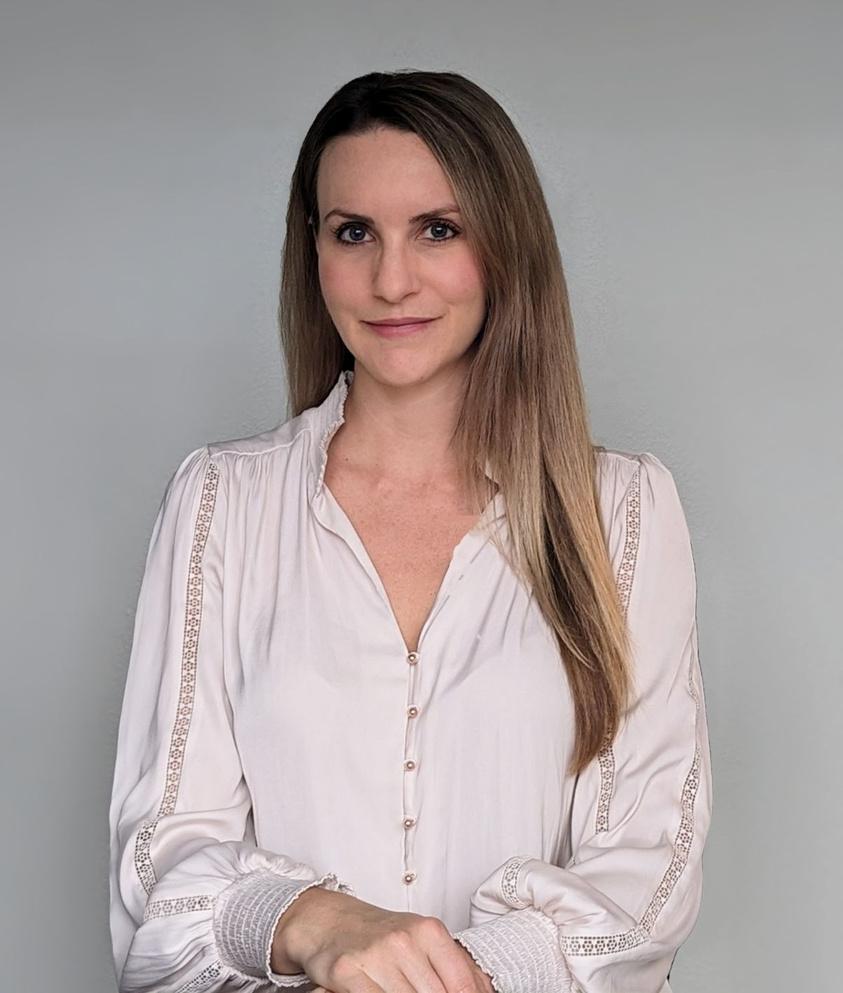
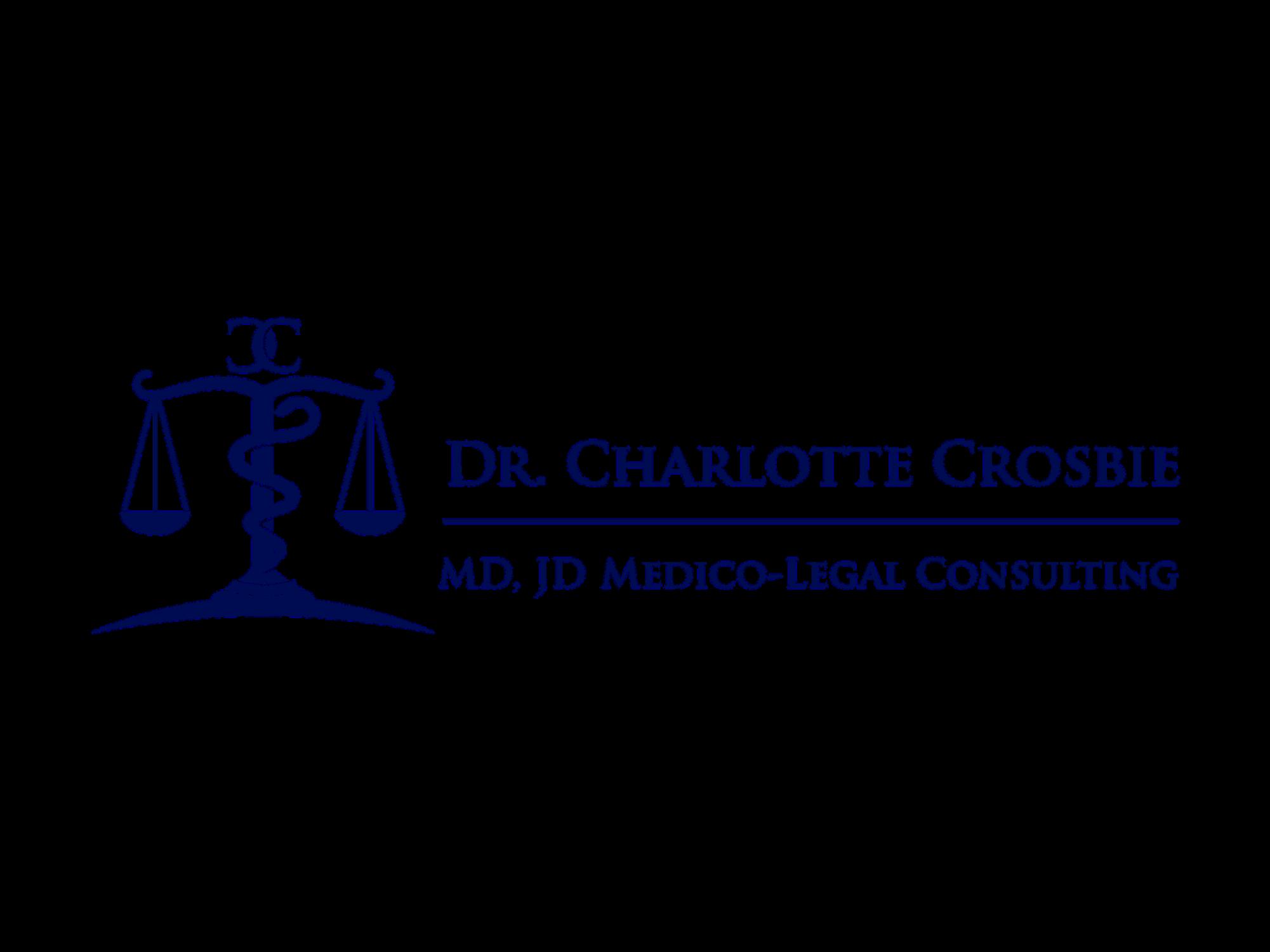
Cost-effective viability reviews
Sourcing other experts
Review of claims and court documents

Preparation for discovery, mediation and trial
The Applicant advanced the argument that that there was not another party “adverse in interest” to 1-888-417-2024 CCrosbie@crosbiemedicolegal

the Respondents. Graesser J. concluded that, subject to Rule 5.13, no valid objection to the Advocates proposed Questioning could be made on the basis that the Advocate and the OYCA are not “adverse in interest” to the Plaintiff. He concluded this on the basis that until April 1, 2012 (the date in which the Act came into effect) the Advocate reported to the Minister of Children and Family Services and the OCYA was part of the Ministry of Children and Family Services, and thus were compellable to testify in any proceeding, just like any other government officer or employee, pursuant to s. 11 of the Proceedings Against the Crown Act, RSA 2000, c P-25. Further, in the event that the OYCA was somehow considered independent from the Crown, attendance for Questioning would likely be secured by using the “near employee” provisions of Rule 5.18, as if someone is not included in Rule 5.17, Rule 5.18 provides for the Questioning of “near” employees or officers.
The Plaintiffs sought records categorized by Graesser J. as the “Initial Advice Documents” and the “Subsequent Documents”. As for the Initial Advice Documents, the Applicants cited Dreco Energy Services Ltd v Wenzel, 2009 ABQB 574, where Greckol J. (as she then was) held that Rule 5.13 required that the requested documents be defined with specificity. Graesser J. distinguished the case from the matter at hand since the Plaintiffs were seeking documents that the Defendant gave to the Applicants, and because the Applicants were not true third parties since they were part of the “Crown”. Graesser J. was satisfied that the Initial Advice Documents existed and did not see how the Plaintiffs could have provided any better description of what they were looking for. Graesser J. did not feel the need to address the issue of relevance and materiality of the Initial Advice Documents, as they appeared to go to the heart of a live issue and Questioning on them automatically flowed from that. Thus, he concluded that the proposed Questioning was not contrary to Rule 5.17. Graesser J. concluded that ongoing communications, if there are any, between the Applicants and the Government as to the issue of suing for Government wrongs allegedly done to children in care would be relevant for the same reasons as above. Records dealing with possible claims against the Government and how those situations were handled by the Applicants would also be relevant, assuming any such claims were referred to the Applicants and any records exist. Though the Applicants argued that the Plaintiff could not embark on a fishing expedition, Graesser J. concluded this was not the case as it was a logical assumption to believe ongoing communications would exist, and because the Applicants themselves will know if the communications exist.
The Applicants further argued that the Advocate did not personally have records, and therefore no records could not be compelled under Rule 5.13. Graesser J. stated that though the Advocate may not have personal control over the records, as an employee she had access to such records. Thus, he concluded that to the extent that the Applicants have possession of or control over the any of the records sought in the Plaintiffs’ Application (but for privileged documents), they were clearly producible under Rule 5.13.
Thus, the Application by the Advocate and the CYAO was dismissed. As it pertained to Costs, the Applicants suggested that the Plaintiffs’ counsel was improper and sought to cancel the appointment for Questioning as being unnecessary, improper, or vexatious under Rule 5.19. The Applicant alleged that the Plaintiffs’ counsel had repeatedly contacted employees of the OCYA attempting to obtain information that was not within the public domain, calling the behavior improper, harassing and an annoyance to the OCYA. Graesser J. found, to the contrary, that the Applicant’s personal attacks warranted enhanced Costs therefore set Costs at double the appropriate column for a contested Application with Briefs.


Rule 5.13 (Obtaining Records from Others)
This was an Application under Rule 5.13 to compel an adjusting firm to provide a witness transcript for use in legal proceedings. The Respondents opposed the Application based on litigation privilege. The transcript was an interview with a former employee, and the main issue was whether it fell under litigation privilege. The interview included a lawyer representing the CGL insurer, the director and manager of a roofing contractor, and an employee from an independent adjusting firm. The interviewee was a former employee of the subcontractor of the roofing contractor
The case outcome depended on whether the interview could be considered as falling within common interest privilege. Applications Judge Prowse noted that the primary purpose of the interview was to assess coverage, and struggled to identify a significant common interest among the parties involved. The independent adjuster’s argument indicated they were unaware of which party the lawyer represented during the interview, making it difficult to support the notion of common interest privilege. Ultimately, the Court determined that the transcript was not protected by litigation privilege.
Rules 5.13 (Obtaining Records from Others) and 5.17 (People Who may be Questioned)
The Applicants applied for a Stay pending Appeal an Order of a Case Management Justice. In that Order, one of the two Applicants was required to submit for Questioning, while the other Applicant, the Office of the Child and Youth Advocate (the “OCYA”), was required to produce records from 2004. The OCYA was not a party to the underlying Action.
The Applicants argued that the Case Management Justice erred in law by: (1) concluding that the provisions in the Child and Youth Advocate Act, SA 2011, c C-11.5 (the “CYAA”) regarding production of records and Questioning did not apply retroactively; and (2) misapplying Rules 5.13 and 5.17(d), which address production of third party records and the right to question a party respectively.
In dismissing the Respondents’ argument that the Appeal was frivolous, the Court found that the Applicants had raised serious questions as to whether the procedural provisions in the CYAA applied to the Respondents’ requests for records and Questioning, and whether Rules 5.13 and 5.17(d) were properly applied. Further, the Court found that the Applicants had established a likelihood of irreparable harm as the Appeal would be moot if the Applicants were required to comply with Questioning and production requirements, which could not be undone. The Court also found that the Stay was not significant and that the balance of convenience favoured the granting of a Stay considering all of the circumstances.
Based on the above analysis, the Court granted the Application.

Rules 5.31 (Use of Transcript and Answers to Written Questions) and 6.7 (Questioning on Affidavit in Support, Response and Reply to Application)
In relation to a Special Application, the Court considered, among other issues, an updated Affidavit which was filed by the Plaintiff which relied on and referred to the transcript of a Questioning on Affidavit conducted by the Defendant. The Defendant objected to use of this Affidavit (the “Objected to Affidavit”). The Objected to Affidavit was objected to on the basis that the submission was contrary to Rule 5.31, which restricts the use or reliance of a Part 5 Questioning transcript to the questioning party, not the questioned party. The Court determined that there had been confusion because of the use of the word “questioning” within Rule 5.31, which applies to Questioning for discovery, and Rule 6.7, which applies to Questioning on Affidavit.
The Court accordingly found that there was nothing improper about the Plaintiff relying on or referring to their own Questioning on Affidavit in the Objected to Affidavit and the filing of the entirety of the Questioning on Affidavit transcript for the purposes of the Application, noting that it should have been done so by the questioning party.
Rules 5.34 (Service of Expert’s Report) and 6.11 (Evidence at Application Hearings)
The Plaintiff, Prabjot Singh Wirring (“Mr. Wirring”) claimed that the portion of the oath allegiance to the sovereign violated his rights to religious freedom and equality guaranteed by the Charter. The Defendant, His Majesty the King in right of Alberta (“Alberta”), applied to strike or alternatively to summarily dismiss the claim. Mr. Wirring opposed Alberta’s Application and applied for Summary Judgment.
Mr. Wirring swore and filed an Affidavit, along with another Affidavit by Harjeet Grewal (“Grewal Affidavit”) in support. Alberta opposed the Grewal Affidavit stating that it included an unqualified expert opinion and did not comply with Rule 5.34. Mr. Wirring argued that Rule 6.11(1)(a) permits the filing of expert evidence. Both parties relied on a previous case, ANC Timber Ltd v Alberta (Minister of Agriculture and Forestry), 2019 ABQB 653, which established that opinion evidence is generally inadmissible but can be allowed for matters requiring specialized knowledge. The Court noted that expert evidence should be introduced as it would at Trial, with the expert’s qualifications and scope of opinion clearly defined. Justice Johnston considered the fact that Dr. Grewal, the expert in question, had impressive qualifications and expertise in religious studies, particularly in Sikhism. Dr. Grewal’s opinion provided necessary and relevant information to Mr. Wirring’s case based on the tenets of his faith. The Court concluded that there were no concerns about Dr. Grewal’s qualifications, and Alberta did not challenge the evidence or seek to cross-examine him. Therefore, admitting the Grewal Affidavit would have significant benefits with no corresponding harm, and therefore was considered admissible.
ALBERTA DRYWALL & STUCCO SUPPLY (CALGARY) INC V ALBERTA DRYWALL & STUCCO SUPPLY INC, 2023 ABKB 696 (DUNLOP J)
Rules 5.35 (Sequence of Exchange of Experts’ Reports) and 5.37 (Questioning Experts Before Trial)
The Defendant applied for an Order requiring the Plaintiff’s expert or the Plaintiff to provide the documents referred to in the expert’s report and used by the expert in preparing his report which had not been previously disclosed, and for an Order directing the Plaintiff’s expert to attend for Questioning on his report. All the infor-


mation relied upon by the expert had been disclosed, except for the discussions between the expert and the principal of the Plaintiff, which were referenced in the expert report.
The Defendant argued that the Plaintiff had waived privilege over its expert’s report when it was filed and served. The Court noted that there are two lines of authority on this issue in Alberta: one line of authority holds that privilege over an expert’s report and the material the expert relied upon is not waived until the expert is called as a witness, and the other line of authority holds that privilege is waived when the expert report is served, as is required for the expert to be called at Trial pursuant to Rule 5.35. The question, therefore, was whether the Plaintiff had waived privilege over the discussions between the principal of the Plaintiff and the expert by serving the expert report on the Defendant.
The Court held that the Supreme Court of Canada’s decision in R v Stone, [1999] 2 SCR 290, stands for the principle that once a party has committed to calling an expert at Trial, privilege over the expert’s report is waived and the opposing party is entitled to the report and all foundational information. However, Dunlop J. disagreed with Feasby J.’s recent ruling in Ho v Connell, 2023 ABKB 133, that “[t]he waiver of privilege with respect to foundational information occurs when the expert report is exchanged because it is at that time when the party delivering the expert report signals to the other side its intention to rely at trial on the expert report.” Justice Dunlop held that a party is free to not call an expert at Trial whose report it previously served and that all that a party serving an expert report does is keep its options open. Accordingly, the Court found that the Plaintiff did not waive privilege over the communications merely by serving the expert report. The privilege would be waived if the expert is called at Trial, or if the Plaintiff did something that commits the Plaintiff to calling the expert as a witness at the Trial. The Defendant’s Application was therefore dismissed. Justice Dunlop also held that while the Defendant may be entitled to know what material the expert had but did not rely upon if he testifies at Trial, that information remained privileged at this stage in the proceedings.
The Court then considered the Defendant’s Application to question the Plaintiff’s expert pursuant to Rule 5.37. Rule 5.37 requires “expectational circumstances” to be shown. Justice Dunlop found that the circumstances referred to by the Defendant, namely that the case is in case management, is highly contentious, and the quantum of damages is significant, did not constitute “exceptional circumstances”, and dismissed the Application.
Rules 5.36 (Objection to Expert’s Report), 6.7 (Questioning on Affidavit in Support, Response and Reply to Application) and 10.33 (Court Consideration in Making Costs Award)
The Defendant, SysGen Solutions Group Ltd (“SysGen”), provided IT services to the Plaintiff, Serinus Energy Plc (“Serinus”). SysGen used its continued access to Serinus’ information systems to remove Serinus’ administrative access to its own systems at a time when Serinus was transitioning away from SysGen to a new IT service provider. SysGen changed Serinus’ passwords, which locked Serinus out from administrative control of its system, without notice to Serinus and immediately after Serinus disputed a SysGen invoice for services during the transition period. SysGen asserted that it did this to investigate a security threat to Serinus’ system. SysGen failed to return administrative access, and instead made a settlement offer using Serinus’ administrative access as part of a settlement of the billing dispute. Serinus took matters into its own hands and managed to break into

its own system to regain control.
Serinus filed a Statement of Claim alleging that SysGen acted with the intent to ransom Serinus for disputed invoices, and claimed breach of contract, breach of fiduciary duty, conversion, and intrusion upon seclusion. SysGen filed a Statement of Defence and Counterclaim for unjust enrichment stemming from unpaid invoices. The matter proceeded by Summary Trial. The parties relied on a jointly filed Compendium of Pleadings and Evidence (the “Compendium”), which included evidence from 13 witnesses, including two experts. Eight of the civilian witnesses were questioned on their Affidavits pursuant to Rule 6.7. The parties agreed that the evidence in the Compendium, other than the expert reports which were objected to pursuant to Rule 5.36, was admissible evidence. No viva voce evidence was heard, and the matter proceeded directly to two days of final argument.
The Court noted that Part 7, Division 3 of the Rules govern Summary Trial, and that the well-established test for whether a Summary Trial is appropriate, pursuant to the Decision in JN v Kozens, 2004 ABCA 394, is (1) can the Court decide disputed questions of fact on Affidavits or by other proceedings authorized by the Rules for a Summary Trial? And (2) would it be unjust to decide the issues in such a way? The Court found the first branch of the test was met as there was an extensive documentary record that the parties had organized, and that both parties agreed there was not a significant dispute on the facts, but rather disputes about the legal effects of what happened. The Court, in considering the second branch of the test, held that while the Court of Appeal has warned that Courts should not give unreasonable weight to the agreement of parties as to the suitability of the Summary Trial process, “I interpret this only to mean that the parties’ agreement is not determinative but is one factor to consider.” It is, however, an important factor to consider because it respects that counsel will have the best understanding of the issues at play. After considering the non-exhaustive list of factors as to whether it would be unjust to proceed by Summary Trial, as laid out in Shaufert v Calgary Co-Operative Association Limited, 2021 ABQB 579, and noting the parties agreement, the Court held that the matter was appropriate for Summary Trial.
After qualifying both parties experts, and considering the evidence set out in the Compendium, Marion J. held that Serinus was entitled to $5,000 in personnel costs that salaried employees spent responding to the system lockdown, $42,012.50 in amounts paid to iON Work for services in response to the system lockdown, and $50,000 in punitive damages based on SysGen’s conduct, totalling $97,012.50. However, Serinus was entitled to judgment of $53,137.89 for unpaid services. After set-off, Serinus was granted Judgment against SysGen for $43,874.61.
The Court held that if the parties were unable to agree on Costs, they could provide written submissions addressing the Rule 10.33 factors, any Formal Offer of settlement they wished the Court to consider, a draft proposed Bill of Costs pursuant to Schedule C, and a summary of their proposed reasonable and proper Costs that the party incurred in respect of the Action.
Rules 6.46 (Referee’s Report) and 7.3 (Summary Judgment)
The Plaintiffs applied for Summary Judgment against the Defendant and Summary Dismissal of the Counterclaim.
Feth J. cited Weir-Jones Technical Services Incorporated v Purolator Courier Ltd, 2019 ABCA 49 and Hannam v Medicine Hat School District No 76, 2020 ABCA 343 for the propositions that Summary Judgment is available where the moving party establishes the facts at issue on a balance of probabilities and demonstrates that no


genuine issue remains for a Trial. Further, the evidence must be sufficient so that the Judge is confident the dispute can be fairly resolved without a Trial.
If the moving party meets the initial burden of showing “no merit”, the resisting party must then put its best foot forward to demonstrate that a triable issue remains. Feth J. reminded us that a party cannot resist summary disposition by speculation about what might turn up in the future.
Feth J. further commented that although the Application does not contemplate Summary Judgment on difficult factual questions, Summary Judgment is not limited to cases where the facts are not in dispute. The Court can make contested findings of material facts and make material fact findings.
Citing Hryniak v Mauldin, 2014 SCC 7 and Weir-Jones, Feth J. commented that the facts pleaded in the Statement of Claim and the Counterclaim are not assumed to be true. The record must enable the Court to make the necessary findings of fact and determine the applicable law. The Court must also reflect on whether the claim or part of it may be fairly and justly resolved at this stage of the litigation.
Having found that the liability for the debt had been determined in foreign Courts of competent jurisdiction, Feth J. concluded that the Plaintiffs were entitled to partial Summary Judgment. As the full amount owing could not be determined on the evidence submitted, Feth J. referred the determination of the balance of the debt amount to a Referee, pursuant to Rule 7.3(3).
Feth J. further held that, pursuant to Rule 6.46, the Referee shall make a report to the Court on the assessment of the debt amount. A copy of the report must be filed and served on the parties. After the report has been served, a party may apply to adopt the report in whole or in part, vary the report, require an explanation from the Referee, remit the whole or part of the assessment to the Referee for further consideration, or decide the assessment on the evidence taken before the Referee with or without additional evidence. The Court held that the Acting Chief Justice would then determine whether that Application should be assigned to another Judge.
As the Counterclaim allegations had been determined by Courts of competent jurisdiction, Feth J. dismissed the Counterclaim.
Rule 7.5 (Application for Judgment by way of Summary Trial)
This Action concerned three principal parties: (1) Denhoed, the Plaintiff, who initiated the Action against Constable Kanyo, The City of Lethbridge, and Lethbridge Police Service (“LPS”) following a collision on a highway; (2) Constable Kanyo, representing LPS and The City of Lethbridge, who responded to an initial collision and whose police cruiser was involved in a secondary collision with a vehicle driven by Griffiths, and; (3) Griffiths, whose subsequent collision with Kanyo’s cruiser ignited the central issue of negligence and standard of care.
The dispute chiefly scrutinized a) whether Constable Kanyo’s handling of the scene met the requisite standard of care, specifically focusing on the parking of his cruiser and the use of emergency lights, and b) if Griffiths’ collision with the cruiser was a result of negligence.

The Court found that Kanyo followed the traffic stop protocol by positioning his cruiser with activated emergency lights to secure the scene, in line with sections 43, 63(4) and 67 of the Use of Highway and Rules of the Road Regulation, Alta Reg 304/2002. The Court found that the arrangement successfully diverted traffic away from the scene for 25 minutes until the collision with Griffiths transpired.
The Summary Trial Order allowed rebuttal Affidavits under Rule 7.5(3)(a). Denhoed didn’t provide rebuttal expert evidence but submitted a response Affidavit sharing her road experiences to counter the Defendant’s expert evidence, suggesting other factors may have influenced Griffith’s view during the incident. The Court found the speculative evidence on what Griffiths observed or the factors affecting his reaction to be unhelpful in determining liability.
The Court affirmed that Kanyo’s actions aligned with the standard of care expected from a reasonable officer under similar circumstances. It found Griffiths solely liable for the subsequent collision under the Traffic Safety Act, RSA 2000, c T-6 for careless driving. The Action against Kanyo, The City, and LPS was dismissed.
Rules 9.14 (Further or Other Order after Judgment or Order Entered) and 10.30 (When Costs Award May be Made)
The Respondent successfully applied before an Applications Judge for an Order enforcing an Undertaking of the Appellant to pay Costs to the Respondent. The Appellant appealed that Decision, arguing that the Applications Judge did not have the power to grant the Order because he was functus officio.
Justice Malik considered whether Rule 10.30(1)(c) or Rule 9.14 created an exception to the functus officio doctrine when the issue concerned Costs. In reviewing the jurisprudence, Justice Malik confirmed that both Rule 10.30 and Rule 9.14 are exceptions to the doctrine of functus officio. Both allow for the granting of further Costs Awards after final Judgment or Order has been pronounced and constitute a Rules-based exception to the application of the functus officio doctrine.
Further, and in any event, Malik J. held that the doctrine of functus officio did not apply in enforcing an Undertaking, as it did not require the Applications Judge to revisit the Costs Award. The Appeal was therefore dismissed.
The Applicant appealed the Decision of Applications Judge Schlosser, which set aside a Default Judgment obtained by the Applicant against the Respondent.
The Applicant served the Respondent with a copy of the Statement of Claim by delivering it to the Respondent’s registered office. Due to the COVID-19 pandemic, the office was closed, and the Statement of Claim was not received by an employee of the Respondent. Thus, an envelope containing the Statement of Claim was placed under the door of the Respondent’s office. Pursuant to Rule 11.27(1), an Application seeking an Order validating service was made and then subsequently granted in favour of the Applicant (the “Validation Order”).
The Respondent filed an Application to set aside the Validation Order and the Noting in Default. Applications Judge Schlosser found that the Noting in Default was irregular because the method of service was not one permitted by the Rules. He also concluded that the Statement of Claim was not brought to the attention of the


Respondent. As a result, he set-aside the Noting in Default and the Default Judgment and provided the Applicant 20 days to file a Statement of Defence.
Fraser J. upheld the Decision rendered by Applications Judge Schlosser’s concluding that the Court based its analysis on Rule 9.15(1) and 9.15(3), which allows the Court to set aside, vary or discharge a Judgment or an Order. Applications Judge Schlosser was entitled to rely on Rule 9.15(1) and 9.15(3), as there had been a procedural irregularity regarding service. The Court provided further justification for upholding the Decision, with Fraser J. agreeing that the Respondent did not strictly comply with the Rules, which likely resulted in the Applicant not being aware of the Statement of Claim.
Rules 9.15 (Setting Aside, Varying and Discharging Judgments and Orders) and 11.25 (Service of Documents Outside Alberta)
This was an Application by the Applicant, Shahin Layeghpour, to appeal a Decision that dismissed his request to set aside a Default Judgment obtained by the Respondent, Leila Rashidi. The Respondent had secured a Default Judgment against the Applicant for unpaid monies invested in a technology project. Despite challenges in serving the Applicant, the Respondent successfully utilized an Order for substitutional service, resulting in a Default Judgment of $8,000. She then commenced collection proceedings.
Upon learning of the Judgment, the Applicant sought to have the Default Judgment set aside. This Application was denied by the Alberta Court of Justice, leading the Applicant to appeal to the Alberta Court of King’s Bench.
In his Appeal, the Applicant raised issues concerning improper service, the jurisdiction of Alberta Courts, and the qualifications for reopening a Noting in Default. The Court determined that service was properly executed under Rule 11.25, as the Applicant was residing in Alberta at the time. The Court also confirmed Alberta’s jurisdiction over the dispute, referring to the Applicant’s residency and the governing law clause in the agreement.
Per Rule 9.15, reopening a Noting in Default requires a reasonable explanation for failing to defend, no unreasonable delay in applying to reopen the Noting in Default, and an arguable defence. The Court held that the Applicant did not present a sufficient defence on the merits. As a result, the Appeal was dismissed.
Rules 11.26 (Method of Service Outside Alberta), 11.27 (Validating Service) and 12.55 (Service of Documents)
The Plaintiff previously filed a Statement of Claim for divorce and applied for a desk divorce. The Court considered whether the Plaintiff had been properly served in accordance with Rules 11.26 and 11.27, as the Respondent appeared to reside in the Philippines.
The Plaintiff was previously granted a substitutional service Order allowing him to serve the Respondent a Statement of Claim for divorce and all other documents in the Action by serving the

Respondent by email to a specific email address. The substitutional service Order was granted on the basis that “the country in which the Respondent resides is a Contracting State to the Hague Service Convention, but the Respondent’s mailing address is not known”.
Rule 11.26 outlines the methods for service outside Alberta. The Court noted that Rule 11.26 requires documents to comply with Division 8 of the Rules where a document is to be served in a jurisdiction to which the Hague Convention on the Service Abroad of Judicial and Extrajudicial Documents in Civil or Commercial Matters (the “Hague Service Convention”) applies. The Court reviewed cases confirming that validating service that does not comply with the Hague Service Convention would undermine the purpose of the convention as it would no longer be a comprehensive authority for service abroad involving its signatories.
The Court confirmed that the Hague Service Convention does not apply where the recipient’s address is not known. However, the Court determined that a party is required to make reasonably diligent efforts to learn the address of the intended recipient rather than simply submitting that the recipient’s address is not known. Upon review, the Court determined that: the evidence before the Court did not demonstrate that the Plaintiff made reasonably diligent efforts to learn the address of the Defendant; and the Plaintiff’s email service failed to comply with the Hague Service Convention, which allows a state to consent to methods of service within its boundaries. There was no evidence that email was an authorized method of service in the Philippines. The Court determined that the Plaintiff failed to comply with Rule 12.55, which requires a Statement of Claim for divorce to be served personally unless the Court otherwise orders. The Court ordered the Plaintiff to reserve the Defendant in accordance with the Hague Service Convention and Rules before re-submitting his desk divorce Application.
Rule 14.5 (Appeals Only with Permission)
This Appeal considered the validity of two lower Court Orders concerning an Attachment Order. The Applicants, Malcolm Innes and his company (together herein “Mr. Innes”), acting as wealth managers, were accused by the Respondents, Jacob Kleiman and Kleiman Resources Ltd. (together herein “Mr. Kleiman”), of mishandling funds.
Mr. Kleiman obtained an ex parte Attachment Order from Justice Kubik under the Civil Enforcement Act, RSA 2000, c C-15, which Mr. Innes sought to have extended (the “Kubik Order”). During a subsequent hearing, Justice Armstrong granted an adjournment to allow for cross-examination on Mr. Innes’ Affidavit, maintaining the original Order and allowing Mr. Innes access to funds for legal fees and living expenses (the “Armstrong Order”).
Mr. Innes appealed both the Kubik Order and the Armstrong Order. The Court of Appeal dismissed the Appeal against the Armstrong Order due to a lack of jurisdiction, as leave for such an Appeal was not obtained in accordance with Rule 14.5(1)(b). The Appeal against the Kubik Order was dismissed as premature, noting that issues related to ex parte Orders should be addressed at the Trial level before an Appeal unless exceptional circumstances exist.
The Court did not find the circumstances alleged by Mr. Innes, which included claims of non-disclosure by Mr. Kleiman, to be exceptional. It was emphasized that any errors in the making of the Kubik Order would be evaluated in a proper forum with a full record. The Court declined to assess the merits of Mr. Innes’ Appeal based on the incomplete record before the Court and without factual findings by a Judge on the evidence.


The Court of Appeal thus dismissed the Appeal.
Costs were awarded to Mr. Kleiman for the Appeal, calculated according to Column 1 of Schedule C to the Rules. An informal offer made by Mr. Kleiman to accept a discontinuance of the Appeal without Costs did not influence the Costs awarded, as it was not found to meet the requirements of a Calderbank offer.
Rules 14.8 (Interest on Judgments), 14.37 (Single Appeal Judges), 14.44 (Application for Permission to Appeal) and 14.50 (Time Limits for Oral Arguments)
This Action revolved around Applications by Julie Cooper and Tower Financial Inc., for an extension of time to seek permission to Appeal, and for permission to Appeal an issue relating to the calculation of prejudgment interest on the non-pecuniary portion of a damages award stemming from a motor vehicle accident.
Following an amendment to the Insurance Act, RSA 2000, c I-3, the rate of prejudgment interest applicable to non-pecuniary damages in motor vehicle accident claims was altered. The Trial Judge applied the new (lower) rate of prejudgment interest from the date of proclamation (December 9, 2020), a Decision which the Appellants sought to challenge.
The Court’s case management officer (CMO) queried the necessity of permission to Appeal under Rule 14.5(1)(g), as the amount in issue appeared to be below $25,000. This Rule necessitates permission to Appeal in such scenarios.
Following this, a timeline was set for the Appellants and the Respondent to file respective materials concerning the Appeal.
The Court noted that Applications for permission to Appeal need to be brought within one month of the Judgment, pursuant to Rules 14.44(1)(b) and 14.8(2). The Appellants were required to satisfy a test to extend time to Appeal under Rule 14.37(2)(c), which a single Appeal Judge could grant. The criteria for the test include a bona fide intention to Appeal within the Appeal period, a justifiable explanation for the delay, absence of serious prejudice, not having taken benefits from the Judgment under Appeal, and a reasonable chance of success on Appeal.
Furthermore, the Appellants needed to establish, under the stipulated test, that there was a reasonable prospect of success and that the Appeal concerned a significant public interest issue, in order to obtain permission to Appeal a decision under $25,000.
Both Applications were granted as the Applicants satisfied the conditions set forth by the Rules, permitting the Appeal and extending the time to file.

Rule 14.45 (Application to Admit New Evidence)
The Applicant sought leave to file a late Application to admit additional evidence on Appeal consisting of documents that he submitted would have changed the Decision in first instance.
Under Rule 14.45(1), an Application to admit new evidence on Appeal must be filed and served prior to the Applicant’s Factum being filed. An Applicant seeking to file a late Application to admit such evidence must seek permission to file.
Fagnan J.A. applied the four-part test from Palmer v The Queen, [1980] 1 SCR 759 for leave to file a late Application to admit new evidence under Rule 14.45(1). Specifically, the evidence generally should not be admitted if it could have been obtained for the hearing through due diligence. The evidence must be relevant in the sense that it relates to a potentially decisive issue in the Trial and must be reasonably capable of belief. Finally, it must be such that it could have reasonably affected the result of the hearing. The Court must also consider whether the proposed Application has a reasonable prospect of success.
Fagnan J.A. observed that the threshold for granting leave is low, and took note that the Court has denied leave where the proposed additional evidence was only marginally relevant or material, where it was irrelevant, and where it was not even arguably probative. Fagnan J.A. further held that although due diligence is not a condition precedent, failure to act with due diligence will generally foreclose the admission of fresh evidence on Appeal.
Having found that the Applicant’s written Application contained only a bare assertion that the evidence was relevant and probative without explaining its particulars or the impact it could be expected to have, Fagnan J.A. denied the Application.
Rule 14.48 (Stay Pending Appeal)
This matter related to an ongoing dispute amongst four siblings each holding 25% of the shares in a closely-held family business. On September 15, 2023, Justice Marion granted an Order that declared that one of the siblings (the “Applicant”) was not permitted to vote at a director’s meeting on May 6, 2019 and, in doing so, breached section 120(6) of the Alberta Business Corporations Act, RSA 2000 c. B-9 (the “ABCA”); and (2) declared that the Applicant was not entitled to vote on any future directors’ vote about the termination of their own employment, provided that none of the exceptions in section 120(6) of the ABCA applied (the “Vote Declaration”).
On October 6, 2023, the Applicant appealed the first two paragraphs of Justice Marion’s Order. He then applied to Stay the Vote Declaration aspect of Justice Marion’s Decision pending Appeal pursuant to Rule 14.48(a). Thus, the issue before the Court was whether the Vote Declaration should be stayed pending Appeal.
Under Rule 14.48, the Applicant seeking a Stay must show: (1) that there is a serious question to be considered on Appeal, (2) that the Applicant will suffer irreparable harm if the Stay is not granted, and (3) that the balance of convenience favours granting the Stay. Even if the tripartite test is not met, the Court can issue a Stay if the interests of justice call for it.


As it pertained to a serious question to be considered on Appeal, the Applicant planned to argue on Appeal that Justice Marion’s interpretation of the meaning of “transaction” was too broad. Justice Marion was satisfied that this was a serious question to be considered on Appeal.
Justice Marion further found that the collective harm caused to the Applicant would render the Appeal nugatory, both legally and practically, due to the potential loss of his right to vote as a director and the disruption to his long-standing employment which may not be practically reversed if he is successful on Appeal. Therefore, the Applicant sufficiently established irreparable harm.
Lastly, Justice Marion considered whether the balance of convenience supported a Stay. If a Stay was not granted, it was likely that the Applicant’s employment would be terminated. On the other hand, the Respondents had delayed in taking any steps to address or confirm the Applicant’s employment during events that gave rise to a portion of the dispute. Then, during the lengthy wait to have their Application heard, they agreed not to take steps pending the outcome of their Application and to preserve the status quo pending clarification of the parties’ rights by the Court. Though the Court acknowledged that the Respondents would like to move on to direct the affairs of the business, the Court found that the balance of convenience favoured a Stay pending the Appeal.
Therefore, Justice Marion granted a Stay pending Appeal of the Vote Declaration portion of the Order.
CANADIAN LIFE AND HEALTH INSURANCE ASSOCIATION INC V THOMSON, 2023 ABCA 340
(PENTELECHUK JA)
Rule 14.58 (Intervenor Status on Appeal)
Canadian Life and Health Insurance Association Inc (the “Association”) applied to intervene in an Appeal regarding the interpretation of a 10-day cancellation clause in the context of a life insurance policy underwritten by the Appellant. The Association sought to intervene, arguing that the Decision may impact the interpretation of all life insurance policies issued in Alberta as well as many issued in the rest of Canada.
The Court reviewed the test for intervention under Rule 14.58(1), which requires determining the proposed intervener’s interest in the subject matter of the proceeding by examining (a) if the intervener will be directly and significantly affected by the Appeal’s outcome, and (b) if the intervener will provide some expertise or fresh perspective on the subject matter that will be helpful in resolving the Appeal.
The Court went on to clarify that a proposed intervener must provide fresh information or a fresh perspective in order to be granted permission to intervene; simply establishing an interest affected by the Appeal is not enough. However, Pentelechuk J.A. went on to state that the test is not “conjunctive” such that a proposed intervener must always establish both. The Court relied on the recent Decision from the Alberta Court of Appeal in VLM v Dominey Estate, 2023 ABCA 226, to support the notion that the test is not strictly conjunctive or disjunctive, but rather involves a consideration of both factors in all cases.
The Court concluded that the Association established a particular interest in the outcome of the Appeal. However, when deciding whether the Association brought any particular expertise or a fresh

perspective to the Appeal, Pentelechuk J.A. found that the submissions came uncomfortably close to taking a position on the merits of the Appeal that aligned with the Appellant. The Court emphasized that there was nothing precluding the Association from working with Appellant’s counsel to flesh out the arguments on Appeal but noted that the purpose of intervention is not to provide “second counsel” by supplementing the efforts of counsel for the parties.
Further, Pentelechuk J.A. found the timing to be problematic, as there was evidence that the President of the Appellant was also a Director of the Association’s Board of Directors, so presumably the Association would have been well aware of the Decision under Appeal. The Court concluded that the late filing of the Application would prejudice the Respondent by impacting their preparation for the Appeal. Thus, Pentelechuk J.A. dismissed the Application.

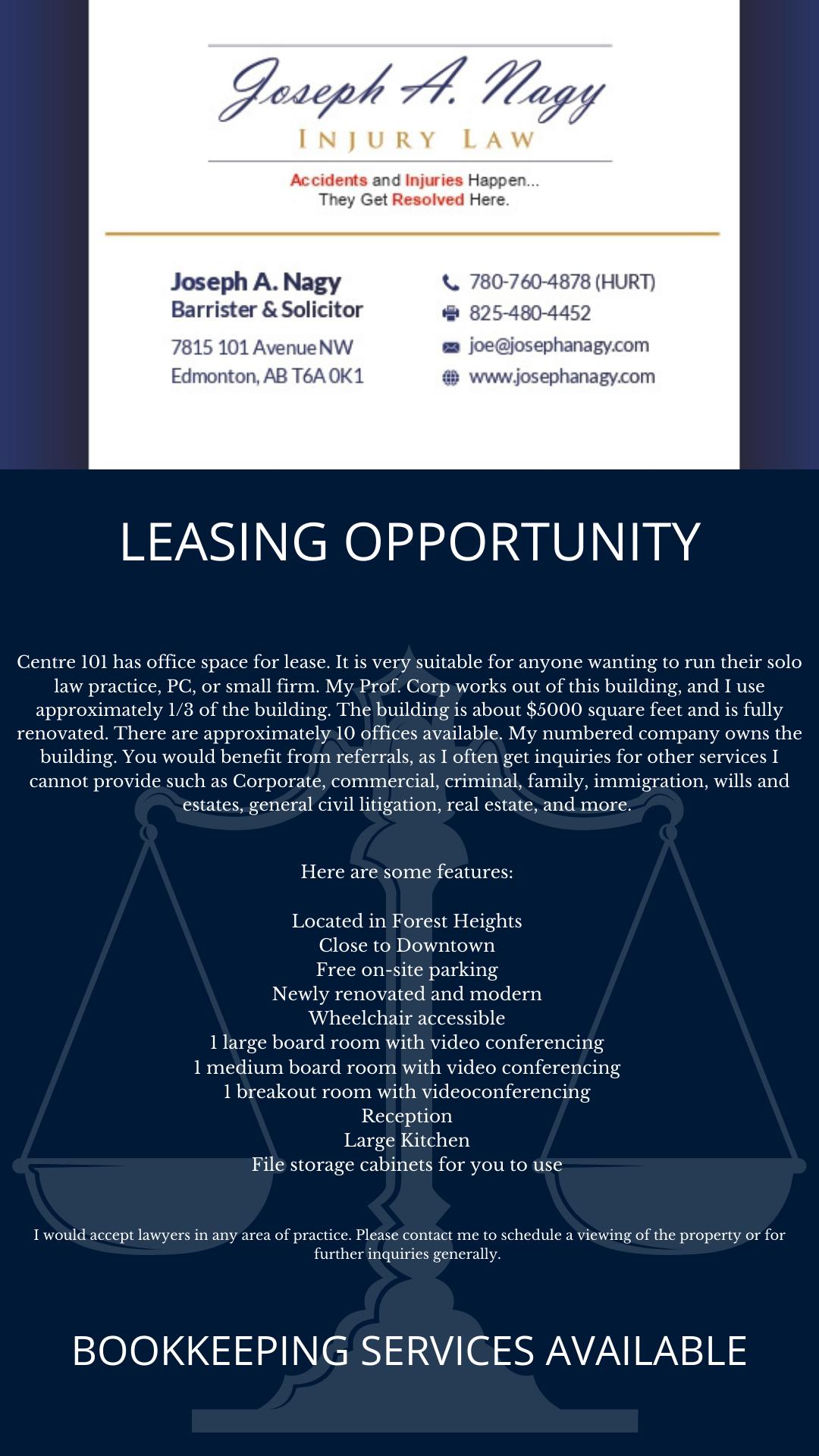
The Alberta Civil Trial Lawyers Association wishes to acknowledge the following members who have shown their support through becoming Sustaining Members of the Association
Daniel Alvarado
Nore Aldein (Norm) Assiff
Ryan Berget
R. Travis Bissett
Maurice J. Blain
Tara Cassidy
Hollick Chipman
Conor J. Clark
Brian Conway
Terrence A. Cooper KC
Meghan Gellein Corrin
Robert L. Duke KC
Mark E. Feehan
Gary R. Frank
Jackie Halpern
Sandra L. Hawes
James A. Hea
William H. Hendsbee KC
William K. Horwitz
Cheryl L. Hostyn
Ross A. Kaplan KC
Walter W. Kubitz KC
Mark Lawson
Roy E. Link
Fredric Litwiniuk
L.D. Todd Litwiniuk
James Ludwar
Robert J. MacKay
Megan L. McMahon
Robert G. McVey KC
Joe V. Miller KC
Waverly Muessle
Joe A. Nagy
Dana C. Neilson
James Royal Nickerson KC
Michael O’Brien
Branislav (Brad) Popovic
Donna Cheryl Purcell KC
Greg Rodin KC
Kathleen A. Ryan KC
Ari Schacter
Martin Schulz
Mark Alexander Smith
Senia Tarrabain
Edward Tawkin
Urvil Thakor
Brian E. Thompson
Timothy R. Wood
David G. Yanko

FC | CaseMark Financial
1 - 800 - 763 - 0025
www.casemarkfinancial.com
9 | Returnity YEG returnityyeg@gmail.com
10 | ACTLA Office Space executivedirector@actla.com
13 | Stark Mediation & Training
403 - 969 - 7967 starkd@shaw.ca
16 | FAIR Alberta https://fairab.ca
17 | Bridgepoint Financial
1- 888 - 800 - 4966 www.bridgepointfinancial.ca
20 | MDD Forensic Accountants
780 - 497-0109 www.mdd.com
20 | Leslie Paetz Mediation
825 - 975 - 2228
lcpaetzmediation@gmail.com
20 | Kimberley Van Burren Mediation
780 - 497-0109
www.mdd.com
22 | North & Company LLP
403 - 328 - 7781
Toll Free: 1 - 800 - 552 - 8022
28 | Viewpoint 1 - 877 - 462 - 4216
viewpointwest@vp-group.ca
29 | Clae Willis 1-877 - 227 - 3752 clae@bellnet.ca
30 | Marney Lutz Mediation
403 - 612 - 7214 marneylutzmediation.com
30 | David Kitchen Mediation
403 - 620 - 2194
davidkitchenmediation.com
30 | Detomasi Dispute Resolution
587 - 349 - 5691 detomasi.ca
30 | Donna Purcell KC Law
1 - 833 - 377 - 2529 www.dpqclaw.com
31 | NYRC
780 - 229 - 5200 www.nyrc.ca
38 | Bottom Line Research
403 - 688 - 2119 www.bottomlineresearch.ca
45 | McKellar Structured Settlements
1 - 800 - 265 - 8381 www.mckellar.com
54 | Dr. Charlotte Crosbie
1 - 888 - 417 - 2024
ccrosbie@crosbiemedicolegal.com medmalexpert.ca
97 | Joseph Nagy Injury Law
825 - 480 - 4452 www.josephnagy.com www.centre101.com
BC | Assiff Law
587 - 524 - 3000 www.assifflaw.com
